Recent Water Damage Posts
Protect Your Home From Water Damage
2/18/2025 (Permalink)
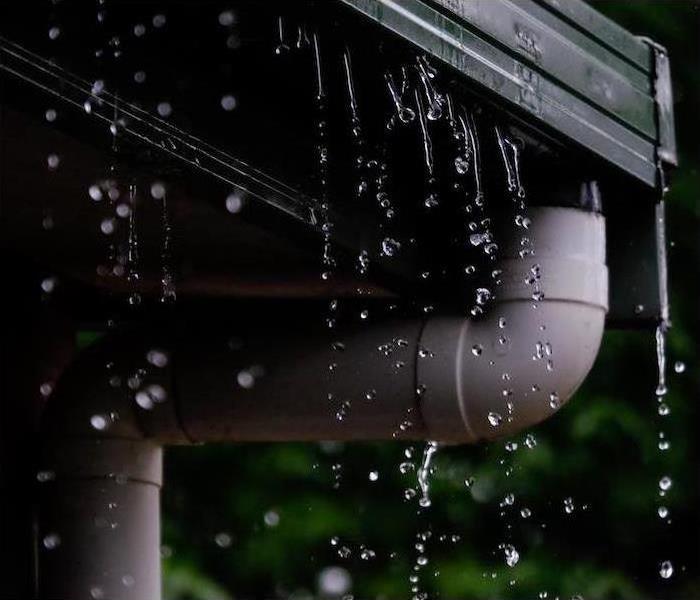 Have water damage in your home? Contact SERVPRO of Billings for quick and professional restoration.
Have water damage in your home? Contact SERVPRO of Billings for quick and professional restoration.
A new year brings new possibilities, and the opportunity for handling projects that can protect your home from potential damages. This year, make preventing water damage to your house a priority by adding easy steps to your regular routines. When you do, you could save yourself from costly damages later.
Water is one of the most common ways homes are damaged, and a tiny, pin-sized hole can wreak complete havoc. Make this year’s resolution to protect your home with simple changes you can really stick to.
What Causes Water Damage?
In order to prevent damages, you need to understand the most common places water leaks happen. Leaks can begin inside or outside your home.
From the outside, your gutters and landscaping are two common ways water does damage, while on the inside of your home, large appliances and bathroom fixtures are often to blame.
Caulking around windows and doors that has broken down can also lead to moisture issues in the home. If leaks aren’t discovered quickly, you could end up with mold or rotted floors.
When an appliance with a water supply like a refrigerator springs a leak, it could stop working or begin to rust. Catching an issue at its source early means you can mitigate damages and prevent financial losses.
How to Prevent Damage
A little bit of water can do a lot of destruction, but there are several ways you can avoid disasters. Finding leaks or other sources of moisture early is always the best way to prevent a total loss, and when you are active in prevention catching an issue will be simple.
To find water in all the wrong places, make checking bathrooms and kitchen for wet spots or signs of mold a regular part of your weekly routine. The next time rain blows through, run your fingers around windows and doors to check for moisture. Confuse your family by sniffing your house to check for a musty smell.
Take a look at your roof once a month and after major wind events to check for loose or missing shingles. Clean your gutters often to allow water to flow away from your home. This step is particularly crucial before winter storms set in to avoid potential ice dams from forming.
Due to the heavy snowfalls we often experience in the winter months, you should also keep a close eye on your roof and attic to ensure there is no structural damage from the weight load. While most homes in our area have guidelines that must be met, if your home is older, you might consider a roof replacement when the weather warms up.
Check your yard regularly to ensure you have proper grading so that water rolls away from your home. Use soil to increase sloping as needed. Add these easy steps into your routines to save yourself from costly repairs later on, and pat yourself on the back for finally making a resolution you really keep!
Have water damage in your home? Contact us for fast, professional restoration back to preloss condition.
How Water Can Seep into Your Home
1/7/2025 (Permalink)
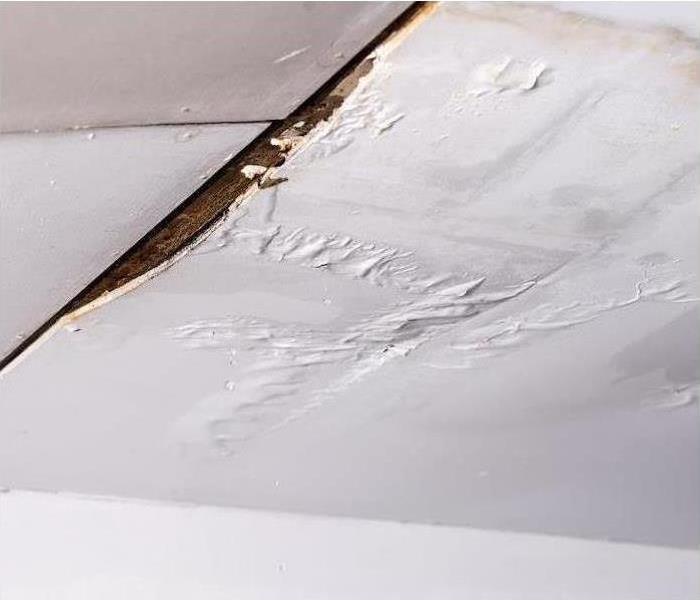 If you experience any water damage inside your home or business, reach out to SERVPRO of Billings.
If you experience any water damage inside your home or business, reach out to SERVPRO of Billings.
You may not notice it, but there could be water seeping into your home. If you have noticed a musty smell, stains on your wall or warped spots in the walls, you could have a leak that when left unattended could cause damage to your home’s foundation.
Extra moisture could also lead to rusty appliances. There are many different things that could indicate a moisture issue in your home, but the most obvious sign will be a puddle of water in the floor.
Any water intrusion can lead to extensive damages. Know what to look for and how to stop it in order to best protect your home.
Water Fixture Leaks
Sinks are a common source of water leaks. A hole or line of deteriorated caulk can lead to seepage and water spots near showers, toilets and bathtubs as well.
Make it a point to check around these areas during regular cleaning, and stop small leaks quickly before they can cause extreme damages. It only takes a tiny leak to waste thousands of gallons of water each year.
Water From Appliances
Large appliances are often sources of unknown leaks. A refrigerator that has a water line or an ice maker and a dishwasher are both at high risk for leaks that can cause serious damage to your floors and lead to a costly and extensive repair.
In order to check for leaks, unplug the appliance and move it away from the wall. Look for standing water and mold spots. If there is any sign of moisture, call us right away to correct the issue quickly and completely.
External Sources
Not all water damage will start inside the home. Weather related leaks can either cause slow moisture buildup or a flood that happens all at once.
Heavy rain and the Yellowstone River create a consistent threat for us throughout the year for flooding.
In the winter, we also contend with heavy snowfall and ice dams that create flooding when it melts. Wildfires that leave natural resources scorched create another hazard when the ground is unable to handle a drenching rain.
You can manage these outside water sources in order to protect your home. Prepare before a flood happens, and maintain those preparations year-round and you can rest assured your property will be safe.
The first step in preparing your home is taking care of your gutter, downspouts and roof. Overfilled gutters can lead to water spillage that may run through your ceilings, walls and into the foundation. Clear out leaves and debris regularly to keep water flowing exactly where it should be.
Check the seals around windows, doors and any other entry points as well. A loose or decayed seal allows water and moisture indoors that could lead to mold growth and damages.
The landscaping in your yard plays a big role in protecting your home as well. Create slopes away from your property to keep water flowing downhill and out of your basement. When you are prepared, you can rest easy knowing you are safe.
If you experience water damage inside your home or business, call us, 24⁄7. We have the experience and equipment to get your property back in working order fast.
Flood Safety for the Inside & Outside of Your Home
10/8/2024 (Permalink)
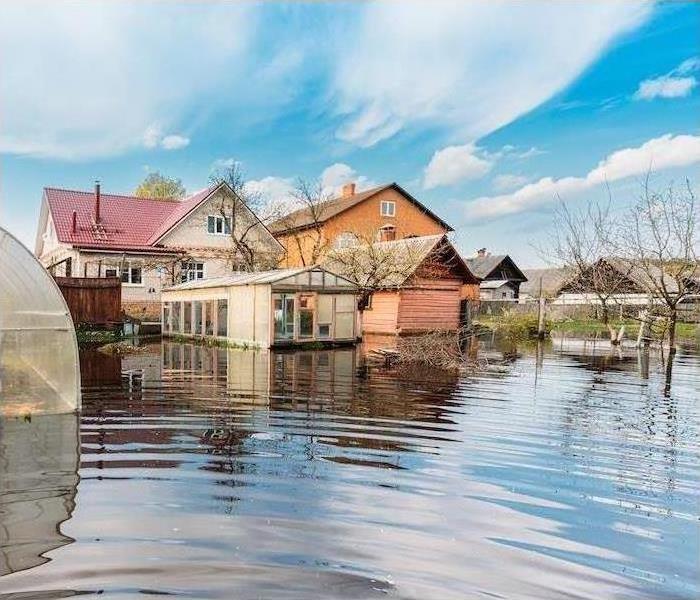 Experienced water damage in your home? Call SERVPRO of Billings to get the restoration process started right away.
Experienced water damage in your home? Call SERVPRO of Billings to get the restoration process started right away.
Regardless of where you live, it is important to make sure you are protected from floods. As little as an inch of water can cause damage and cost any property owner quite a bit in repairs.
If you do not live in an area that has frequent flooding, you may not qualify for a lot of financial help through insurance or other sources. This means that every preventive measure you can take is crucial.
Flooding is a fairly common occurrence for us in Billings and our surrounding areas. In the warmer seasons, the rivers around us are consistently challenged by heavy rains. This makes it essential to know your risks so that you can properly prepare your home and ensure your family’s safety.
Protecting Your Home From the Outside
Flooding cannot always be anticipated with a great deal of time to prepare. Pop-up storms can dump huge amounts of water in a short amount of time that causes puddles to form around your home and overwhelms your gutter systems.
Protecting your home starts with preparing from the outside.
Clean gutters are crucial in ensuring water flows away from your home. With the heavy rains we can frequently experience in June and July, adding an extended downspout to your gutter system could be helpful to prevent overflow and puddling.
You can also use landscaping to protect the bottom level of your home. Gardens pull water down into soil and roots, which means heavy rains are absorbed faster and puddles are avoided.
Organic materials like mulch are also helpful when added to the area immediately outside of your home. Create a slope with these materials to force water away and avoid wet basements or bottom floors.
There are a few upgrades you can consider to protect your home in extreme weather as well, including elevating electric outlets and anchoring fuel tanks if you use one. While those may seem like high-end additions, adding an inexpensive rain barrel that catches water directly from one of your downspouts can be a helpful way to prevent water gathering. And bonus: It means saving money when you water all your beautiful plants!
Flood Protection From the Inside
Two of the best ways to protect the inside of your home are sealing your basement and tackling any cracks in your foundation.
A sump pump in the basement that kicks in when water enters can also be a helpful tool in keeping your home dry. If you live in a high-risk area, a battery-operated pump might be the best idea so you are ensured it will work even if the power goes out.
For flooding that doesn’t start outside, there are a few ways to protect your home with basic home maintenance.
Plumbing is one of the biggest sources of water damage inside the home, particularly pipes that are aged or failing. If you have a leaky faucet, get it fixed quickly and make checking all of your plumbing a regular habit so that other leaks don’t start.
You can also consider adding a leak sensor that will tell you if water is suddenly somewhere it shouldn’t be. Home security systems will sometimes offer this as an add-on or upgrade, so if you were considering having a new system put in, spring for this addition and rest a little more peacefully.
No matter where it comes from, water will damage paper goods and photographs immediately. Store irreplaceable items on high shelves or in a water-tight container.
Make sure you also know where your emergency contacts are stored, and consider adding SERVPRO® to the list. The faster you call us, the sooner your recovery starts.
Experienced water damage in your home? Call SERVPRO today to get your restoration completed faster.
What to Know About Appliances and Water Damage
7/23/2024 (Permalink)
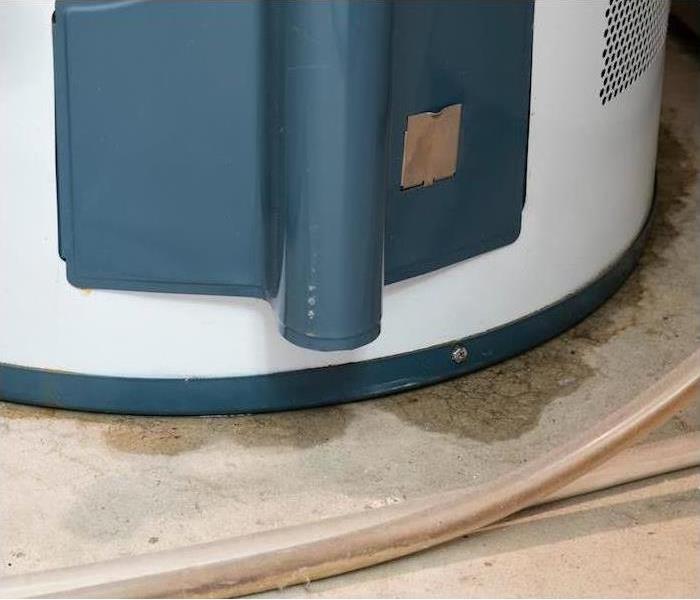 Have water damage in your home from an appliance or another source? Our team is here to help, so call us day or night.
Have water damage in your home from an appliance or another source? Our team is here to help, so call us day or night.
A cold cup of water fresh from the filter in the fridge, the clunk of new ice cubes in the ice maker, clean dishes warm from the dishwasher, the smell of fresh laundry out of the washing machine…we benefit from appliances in our homes that use water all day long. While these appliances make life convenient, they can also leave your home at risk for water damage.
Water damage problems originate in so many different ways, but when it comes to appliances with a water component, it can be particularly challenging to catch an issue before it causes extreme damage.
The good news is that by learning what to look for and adding a few simple steps to your regular routine, you can protect your home and enjoy your appliances worry-free.
Regular Maintenance
One of the best ways to prevent water damage is to check for it often. This can be as simple as using your hand to check for moisture around your appliances.
Leaks can hide underneath your refrigerator or dishwasher, so keep an eye out for unexplained water drops or soft spots in the floor. Pull bigger appliances out away from the wall once a year to clean underneath them. Look for mold while you have them pulled out as another indicator of a leak.
While your HVAC system requires some special care of its own, it is still an appliance that could produce hidden water damage in your home. Along with having it serviced once a year to ensure it is working properly, regularly look for moisture on your vents or puddles near your unit. These are both indications of a problem that could lead to not only water damage, but mold growth and damage as well.
Don’t forget about your water heater—this large appliance is a common source of water issues. Treat it the same way as the rest of your appliances by checking it regularly for signs of leaks.
Yearly or Long-Term Maintenance
Keeping a close eye on your appliances weekly or even monthly can go a long way toward preventing extensive damage, but you should also have your appliances maintained according to the schedule recommended by the manufacturer. This may mean bringing in a professional, but there are also several things you can do on your own.
Check hoses and other tubing on your fridge, washing machine and dishwasher for holes, kinks and signs of wear and tear. Every appliance has a different lifespan, and deteriorated parts should be replaced in order to avoid issues.
Always choose high-quality parts, and replace appliances every 10 to 15 years in order to have the safest products in your home.
While an appliance leak can seem small, it can cause a lot of damage if it isn’t corrected quickly. Keep your home safe and enjoy life’s little luxuries by staying on top of potential problems and avoid costly repairs.
What Can Water Do To Your Home
4/9/2024 (Permalink)
 SERVPRO of Billings is always ready to help in a time of need, if you are experiencing any water damage call us!
SERVPRO of Billings is always ready to help in a time of need, if you are experiencing any water damage call us!
Water damage can be devastating for any home. If a major leak or flood happens, it's important to take action immediately. SERVPRO of Billings can help you clean up and repair your property after water damage has occurred, but the sooner you begin the process, the less costly it will be.
If you're dealing with a leak or flood, it's important to act fast. In fact, water damage can ruin your home faster than you might think. Within the first 24 hours of a leak or flood, mold development, damage to floors, walls, and electrics, and even structural issues can occur. That's why it's always best to quickly hire a water cleanup pro near you for a consultation and repair.
How Bad is Water Damage?
First of all, there's water damage itself, which causes destruction to building materials, appliances, fixtures, and furniture as it sits and pools, with electronics being especially susceptible to damage. Also, mold thrives with water, and it is particularly concerning when moisture is hidden behind walls and in other difficult-to- reach areas. Even worse, depending on where the water came from, water damage leads to health concerns, as sitting water often features all sorts of germs and bacteria.
Quickly Does Damage Occur?
Even what seems to be a small harmless leak can cause damage. Water spreads rapidly and absorbs into everything such as walls, floors, furniture, and more.
Within the First 24 Hours
- As a leak or flood spreads, it will soak everything in the vicinity leaving wet dark spots on floors and walls
- Personal belongings, such as books and photos, can immediately bulge and warp beyond repair
- Furniture, walls, and floors will begin to absorb the water as well
- Drywall, wooden doors, and even window frames can swell
- Paint or wallpaper can peel or blister, and could impact electrical systems.
- If water is on your roof, the leak could come through the ceilings and create damage to insulation and wooden beams
- Mold can develop within this timeframe
Within the First Week
- Mold can spread rapidly and the site becomes a biohazard
- Any damage to wood surfaces and walls will intensify
- Metal surfaces will start corroding
More than a Week
- If you leave water damage for more than a week, the timescales, costs, and effort involved in any restoration work will increase significantly.
- The spread of mold increases dramatically
- Risks associated with structural damage are greater.
Where to Get Help
SERVPRO of Billings specializes in the cleanup and restoration of residential and commercial property after a fire, smoke or water damage event. Our staff is highly trained in property damage restoration. From initial and ongoing training at SERVPRO’s corporate training facility to regular IICRC-industry certification, rest assured our staff is equipped with the knowledge to restore your property.
Regardless of the type of water damage sustained, SERVPRO has the tools and teams to help your home or business recover. Contact us 24⁄7 when you need a dependable team to help you recover.
Protect Your Home From Water Damage | SERVPRO® of Billings
2/20/2024 (Permalink)
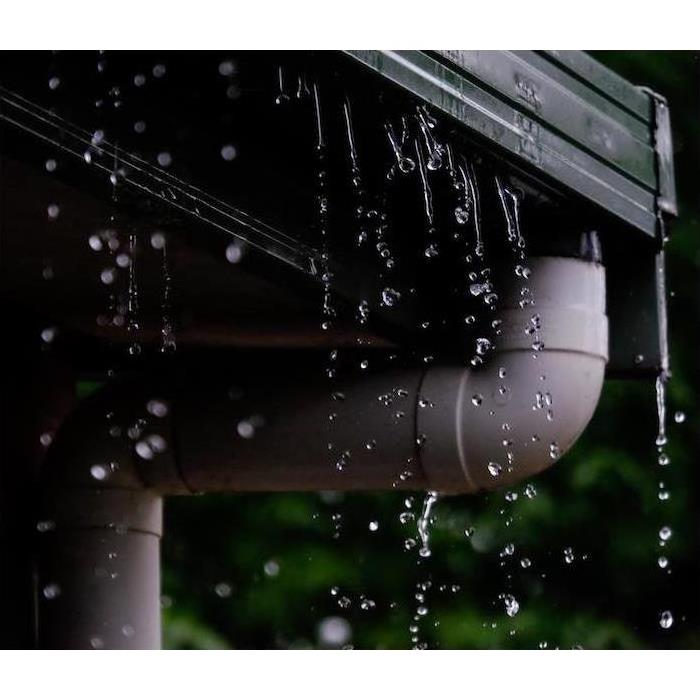 Have water damage in your home? Contact us for fast, professional restoration back to preloss condition.
Have water damage in your home? Contact us for fast, professional restoration back to preloss condition.
A new year brings new possibilities, and the opportunity for handling projects that can protect your home from potential damages. This year, make preventing water damage to your house a priority by adding easy steps to your regular routines. When you do, you could save yourself from costly damages later.
Water is one of the most common ways homes are damaged, and a tiny, pin-sized hole can wreak complete havoc. Make this year’s resolution to protect your home with simple changes you can really stick to.
What Causes Water Damage?
In order to prevent damages, you need to understand the most common places water leaks happen. Leaks can begin inside or outside your home.
From the outside, your gutters and landscaping are two common ways water does damage, while on the inside of your home, large appliances and bathroom fixtures are often to blame.
Caulking around windows and doors that has broken down can also lead to moisture issues in the home. If leaks aren’t discovered quickly, you could end up with mold or rotted floors.
When an appliance with a water supply like a refrigerator springs a leak, it could stop working or begin to rust. Catching an issue at its source early means you can mitigate damages and prevent financial losses.
How to Prevent Damage
A little bit of water can do a lot of destruction, but there are several ways you can avoid disasters. Finding leaks or other sources of moisture early is always the best way to prevent a total loss, and when you are active in prevention catching an issue will be simple.
To find water in all the wrong places, make checking bathrooms and kitchen for wet spots or signs of mold a regular part of your weekly routine. The next time rain blows through, run your fingers around windows and doors to check for moisture. Confuse your family by sniffing your house to check for a musty smell.
Take a look at your roof once a month and after major wind events to check for loose or missing shingles. Clean your gutters often to allow water to flow away from your home. This step is particularly crucial before winter storms set in to avoid potential ice dams from forming.
Due to the heavy snowfalls we often experience in the winter months, you should also keep a close eye on your roof and attic to ensure there is no structural damage from the weight load. While most homes in our area have guidelines that must be met, if your home is older, you might consider a roof replacement when the weather warms up.
Check your yard regularly to ensure you have proper grading so that water rolls away from your home. Use soil to increase sloping as needed. Add these easy steps into your routines to save yourself from costly repairs later on, and pat yourself on the back for finally making a resolution you really keep!
Have water damage in your home? Contact SERVPRO of Billings for quick and professional restoration.
How Water Can Seep Inside | SERVPRO® of Billings
1/9/2024 (Permalink)
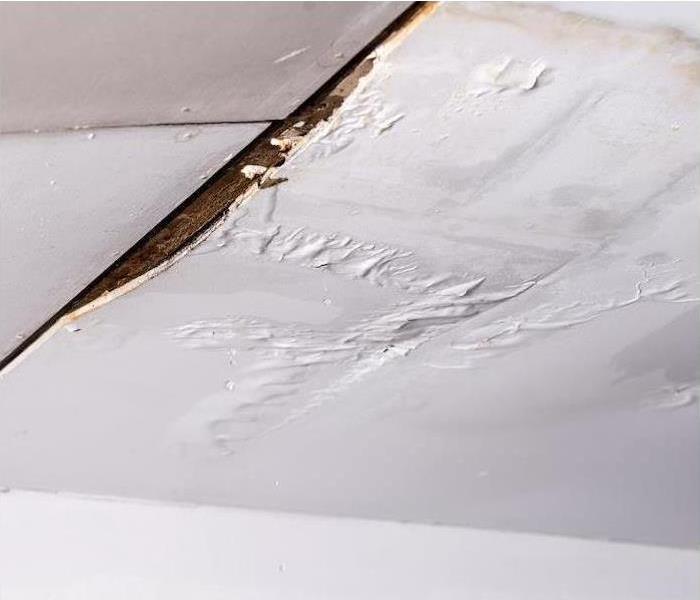 If you experience any water damage inside your home or business, reach out to SERVPRO of Billings.
If you experience any water damage inside your home or business, reach out to SERVPRO of Billings.
You may not notice it, but there could be water seeping into your home. If you have noticed a musty smell, stains on your wall or warped spots in the walls, you could have a leak that when left unattended could cause damage to your home’s foundation.
Extra moisture could also lead to rusty appliances. There are many different things that could indicate a moisture issue in your home, but the most obvious sign will be a puddle of water in the floor.
Any water intrusion can lead to extensive damages. Know what to look for and how to stop it in order to best protect your home.
Water Fixture Leaks
Sinks are a common source of water leaks. A hole or line of deteriorated caulk can lead to seepage and water spots near showers, toilets and bathtubs as well.
Make it a point to check around these areas during regular cleaning, and stop small leaks quickly before they can cause extreme damages. It only takes a tiny leak to waste thousands of gallons of water each year.
Water From Appliances
Large appliances are often sources of unknown leaks. A refrigerator that has a water line or an ice maker and a dishwasher are both at high risk for leaks that can cause serious damage to your floors and lead to a costly and extensive repair.
In order to check for leaks, unplug the appliance and move it away from the wall. Look for standing water and mold spots. If there is any sign of moisture, call us right away to correct the issue quickly and completely.
External Sources
Not all water damage will start inside the home. Weather related leaks can either cause slow moisture buildup or a flood that happens all at once.
Heavy rain and the Yellowstone River create a consistent threat for us throughout the year for flooding.
In the winter, we also contend with heavy snowfall and ice dams that create flooding when it melts. Wildfires that leave natural resources scorched create another hazard when the ground is unable to handle a drenching rain.
You can manage these outside water sources in order to protect your home. Prepare before a flood happens, and maintain those preparations year-round and you can rest assured your property will be safe.
The first step in preparing your home is taking care of your gutter, downspouts and roof. Overfilled gutters can lead to water spillage that may run through your ceilings, walls and into the foundation. Clear out leaves and debris regularly to keep water flowing exactly where it should be.
Check the seals around windows, doors and any other entry points as well. A loose or decayed seal allows water and moisture indoors that could lead to mold growth and damages.
The landscaping in your yard plays a big role in protecting your home as well. Create slopes away from your property to keep water flowing downhill and out of your basement. When you are prepared, you can rest easy knowing you are safe.
If you experience water damage inside your home or business, call us, 24⁄7. We have the experience and equipment to get your property back in working order fast.
Flood Safety for the Inside & Outside of Your Home | SERVPRO® of Billings
10/10/2023 (Permalink)
 Experienced water damage in your home? Call SERVPRO of Billings to get the restoration process started right away.
Experienced water damage in your home? Call SERVPRO of Billings to get the restoration process started right away.
Regardless of where you live, it is important to make sure you are protected from floods. As little as an inch of water can cause damage and cost any property owner quite a bit in repairs.
If you do not live in an area that has frequent flooding, you may not qualify for a lot of financial help through insurance or other sources. This means that every preventive measure you can take is crucial.
Flooding is a fairly common occurrence for us in Billings and our surrounding areas. In the warmer seasons, the rivers around us are consistently challenged by heavy rains. This makes it essential to know your risks so that you can properly prepare your home and ensure your family’s safety.
Protecting Your Home From the Outside
Flooding cannot always be anticipated with a great deal of time to prepare. Pop-up storms can dump huge amounts of water in a short amount of time that causes puddles to form around your home and overwhelms your gutter systems.
Protecting your home starts with preparing from the outside.
Clean gutters are crucial in ensuring water flows away from your home. With the heavy rains we can frequently experience in June and July, adding an extended downspout to your gutter system could be helpful to prevent overflow and puddling.
You can also use landscaping to protect the bottom level of your home. Gardens pull water down into soil and roots, which means heavy rains are absorbed faster and puddles are avoided.
Organic materials like mulch are also helpful when added to the area immediately outside of your home. Create a slope with these materials to force water away and avoid wet basements or bottom floors.
There are a few upgrades you can consider to protect your home in extreme weather as well, including elevating electric outlets and anchoring fuel tanks if you use one. While those may seem like high-end additions, adding an inexpensive rain barrel that catches water directly from one of your downspouts can be a helpful way to prevent water gathering. And bonus: It means saving money when you water all your beautiful plants!
Flood Protection From the Inside
Two of the best ways to protect the inside of your home are sealing your basement and tackling any cracks in your foundation.
A sump pump in the basement that kicks in when water enters can also be a helpful tool in keeping your home dry. If you live in a high-risk area, a battery-operated pump might be the best idea so you are ensured it will work even if the power goes out.
For flooding that doesn’t start outside, there are a few ways to protect your home with basic home maintenance.
Plumbing is one of the biggest sources of water damage inside the home, particularly pipes that are aged or failing. If you have a leaky faucet, get it fixed quickly and make checking all of your plumbing a regular habit so that other leaks don’t start.
You can also consider adding a leak sensor that will tell you if water is suddenly somewhere it shouldn’t be. Home security systems will sometimes offer this as an add-on or upgrade, so if you were considering having a new system put in, spring for this addition and rest a little more peacefully.
No matter where it comes from, water will damage paper goods and photographs immediately. Store irreplaceable items on high shelves or in a water-tight container.
Make sure you also know where your emergency contacts are stored, and consider adding SERVPRO to the list. The faster you call us, the sooner your recovery starts.
Experienced water damage in your home? Call SERVPRO today to get your restoration completed faster.
What to Know About Appliances and Water Damage | SERVPRO® of Billings
7/18/2023 (Permalink)
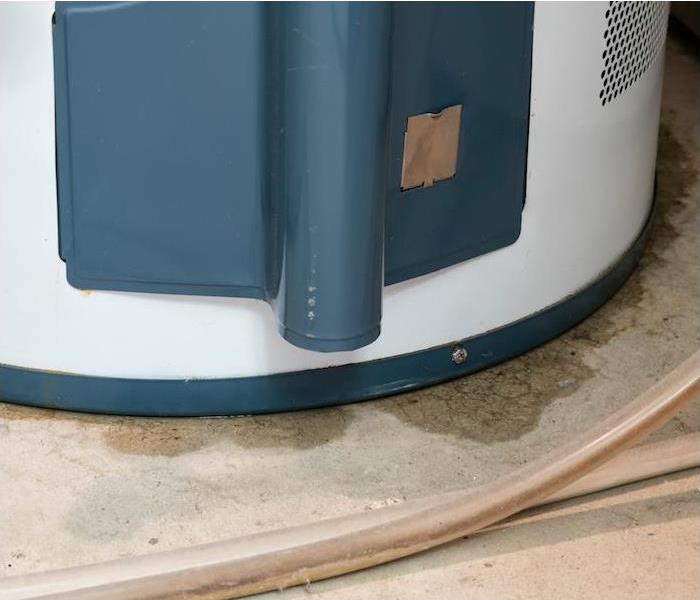 Have water damage in your home from an appliance or another source? Our team is here to help, so call us day or night.
Have water damage in your home from an appliance or another source? Our team is here to help, so call us day or night.
A cold cup of water fresh from the filter in the fridge, the clunk of new ice cubes in the ice maker, clean dishes warm from the dishwasher, the smell of fresh laundry out of the washing machine…we benefit from appliances in our homes that use water all day long. While these appliances make life convenient, they can also leave your home at risk for water damage.
Water damage problems originate in so many different ways, but when it comes to appliances with a water component, it can be particularly challenging to catch an issue before it causes extreme damage.
The good news is that by learning what to look for and adding a few simple steps to your regular routine, you can protect your home and enjoy your appliances worry-free.
Regular Maintenance
One of the best ways to prevent water damage is to check for it often. This can be as simple as using your hand to check for moisture around your appliances.
Leaks can hide underneath your refrigerator or dishwasher, so keep an eye out for unexplained water drops or soft spots in the floor. Pull bigger appliances out away from the wall once a year to clean underneath them. Look for mold while you have them pulled out as another indicator of a leak.
While your HVAC system requires some special care of its own, it is still an appliance that could produce hidden water damage in your home. Along with having it serviced once a year to ensure it is working properly, regularly look for moisture on your vents or puddles near your unit. These are both indications of a problem that could lead to not only water damage, but mold growth and damage as well.
Don’t forget about your water heater—this large appliance is a common source of water issues. Treat it the same way as the rest of your appliances by checking it regularly for signs of leaks.
Yearly or Long-Term Maintenance
Keeping a close eye on your appliances weekly or even monthly can go a long way toward preventing extensive damage, but you should also have your appliances maintained according to the schedule recommended by the manufacturer. This may mean bringing in a professional, but there are also several things you can do on your own.
Check hoses and other tubing on your fridge, washing machine and dishwasher for holes, kinks and signs of wear and tear. Every appliance has a different lifespan, and deteriorated parts should be replaced in order to avoid issues.
Always choose high-quality parts, and replace appliances every 10 to 15 years in order to have the safest products in your home.
While an appliance leak can seem small, it can cause a lot of damage if it isn’t corrected quickly. Keep your home safe and enjoy life’s little luxuries by staying on top of potential problems and avoid costly repairs.
What Can Water Do To Your Home | SERVPRO® of Billings
4/3/2023 (Permalink)
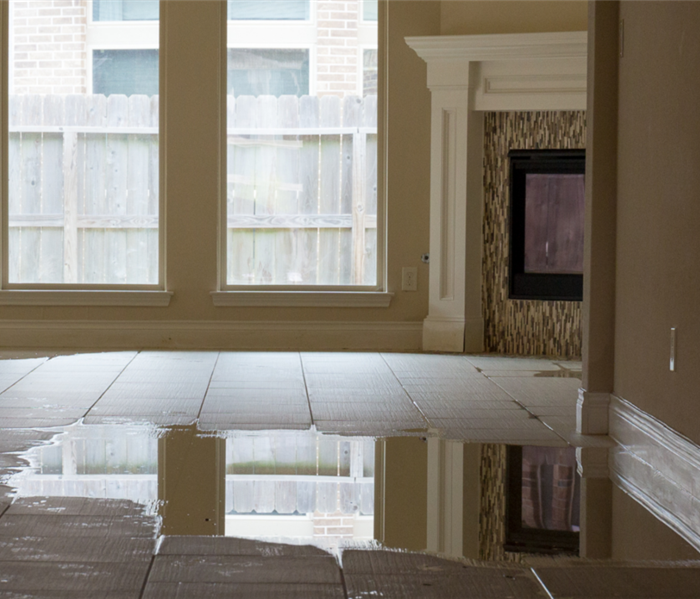 SERVPRO of Billings is always ready to help in a time of need, if you are experiencing any water damage call us!
SERVPRO of Billings is always ready to help in a time of need, if you are experiencing any water damage call us!
Water damage can be devastating for any home. If a major leak or flood happens, it's important to take action immediately. SERVPRO of Billings can help you clean up and repair your property after water damage has occurred, but the sooner you begin the process, the less costly it will be.
If you're dealing with a leak or flood, it's important to act fast. In fact, water damage can ruin your home faster than you might think. Within the first 24 hours of a leak or flood, mold development, damage to floors, walls, and electrics, and even structural issues can occur. That's why it's always best to quickly hire a water cleanup pro near you for a consultation and repair.
How Bad is Water Damage?
First of all, there's water damage itself, which causes destruction to building materials, appliances, fixtures, and furniture as it sits and pools, with electronics being especially susceptible to damage. Also, mold thrives with water, and it is particularly concerning when moisture is hidden behind walls and in other difficult-to- reach areas. Even worse, depending on where the water came from, water damage leads to health concerns, as sitting water often features all sorts of germs and bacteria.
Quickly Does Damage Occur?
Even what seems to be a small harmless leak can cause damage. Water spreads rapidly and absorbs into everything such as walls, floors, furniture, and more.
Within the First 24 Hours
- As a leak or flood spreads, it will soak everything in the vicinity leaving wet dark spots on floors and walls
- Personal belongings, such as books and photos, can immediately bulge and warp beyond repair
- Furniture, walls, and floors will begin to absorb the water as well
- Drywall, wooden doors, and even window frames can swell
- Paint or wallpaper can peel or blister, and could impact electrical systems.
- If water is on your roof, the leak could come through the ceilings and create damage to insulation and wooden beams
- Mold can develop within this timeframe
Within the First Week
- Mold can spread rapidly and the site becomes a biohazard
- Any damage to wood surfaces and walls will intensify
- Metal surfaces will start corroding
More than a Week
- If you leave water damage for more than a week, the timescales, costs, and effort involved in any restoration work will increase significantly.
- The spread of mold increases dramatically
- Risks associated with structural damage are greater.
Where to Get Help
SERVPRO of Billings specializes in the cleanup and restoration of residential and commercial property after a fire, smoke or water damage event. Our staff is highly trained in property damage restoration. From initial and ongoing training at SERVPRO’s corporate training facility to regular IICRC-industry certification, rest assured our staff is equipped with the knowledge to restore your property.
Regardless of the type of water damage sustained, SERVPRO has the tools and teams to help your home or business recover. Contact us 24⁄7 when you need a dependable team to help you recover.
Protect Your Home From Water Damage | SERVPRO® of Billings
2/1/2023 (Permalink)
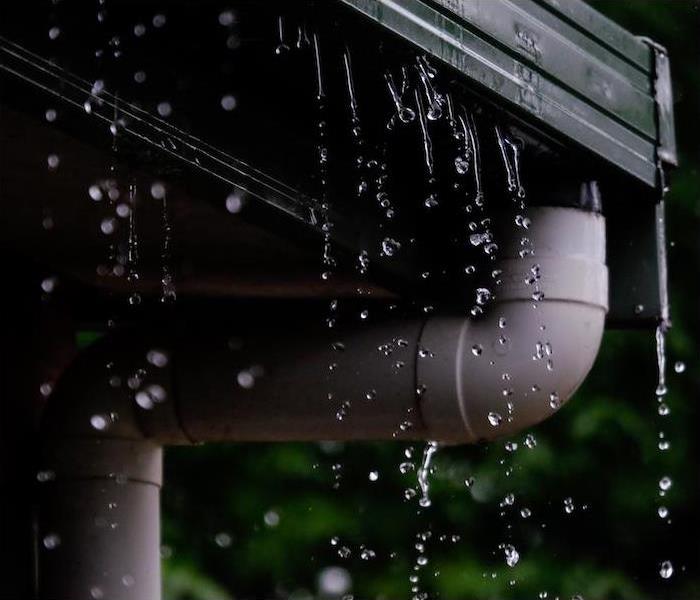 Have water damage in your home? Contact SERVPRO of Billings for quick and professional restoration.
Have water damage in your home? Contact SERVPRO of Billings for quick and professional restoration.
A new year brings new possibilities, and the opportunity for handling projects that can protect your home from potential damages. This year, make preventing water damage to your house a priority by adding easy steps to your regular routines. When you do, you could save yourself from costly damages later.
Water is one of the most common ways homes are damaged, and a tiny, pin-sized hole can wreak complete havoc. Make this year’s resolution to protect your home with simple changes you can really stick to.
What Causes Water Damage?In order to prevent damages, you need to understand the most common places water leaks happen. Leaks can begin inside or outside your home.
From the outside, your gutters and landscaping are two common ways water does damage, while on the inside of your home, large appliances and bathroom fixtures are often to blame.
Caulking around windows and doors that has broken down can also lead to moisture issues in the home. If leaks aren’t discovered quickly, you could end up with mold or rotted floors.
When an appliance with a water supply like a refrigerator springs a leak, it could stop working or begin to rust. Catching an issue at its source early means you can mitigate damages and prevent financial losses.
How to Prevent DamageA little bit of water can do a lot of destruction, but there are several ways you can avoid disasters. Finding leaks or other sources of moisture early is always the best way to prevent a total loss, and when you are active in prevention catching an issue will be simple.
To find water in all the wrong places, make checking bathrooms and kitchen for wet spots or signs of mold a regular part of your weekly routine. The next time rain blows through, run your fingers around windows and doors to check for moisture. Confuse your family by sniffing your house to check for a musty smell.
Take a look at your roof once a month and after major wind events to check for loose or missing shingles. Clean your gutters often to allow water to flow away from your home. This step is particularly crucial before winter storms set in to avoid potential ice dams from forming.
Due to the heavy snowfalls we often experience in the winter months, you should also keep a close eye on your roof and attic to ensure there is no structural damage from the weight load. While most homes in our area have guidelines that must be met, if your home is older, you might consider a roof replacement when the weather warms up.
Check your yard regularly to ensure you have proper grading so that water rolls away from your home. Use soil to increase sloping as needed. Add these easy steps into your routines to save yourself from costly repairs later on, and pat yourself on the back for finally making a resolution you really keep!
Have water damage in your home? Contact us for fast, professional restoration back to preloss condition.
How Water Can Seep Inside | SERVPRO® of Billings
1/2/2023 (Permalink)
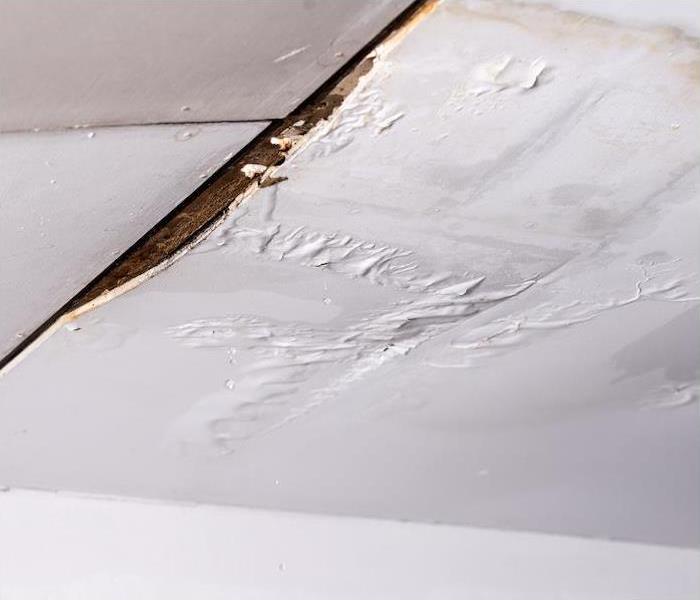 If you experience any water damage inside your home or business, reach out to SERVPRO of Billings.
If you experience any water damage inside your home or business, reach out to SERVPRO of Billings.
You may not notice it, but there could be water seeping into your home. If you have noticed a musty smell, stains on your wall or warped spots in the walls, you could have a leak that when left unattended could cause damage to your home’s foundation.
Extra moisture could also lead to rusty appliances. There are many different things that could indicate a moisture issue in your home, but the most obvious sign will be a puddle of water in the floor.
Any water intrusion can lead to extensive damages. Know what to look for and how to stop it in order to best protect your home.
Water Fixture LeaksSinks are a common source of water leaks. A hole or line of deteriorated caulk can lead to seepage and water spots near showers, toilets and bathtubs as well.
Make it a point to check around these areas during regular cleaning, and stop small leaks quickly before they can cause extreme damages. It only takes a tiny leak to waste thousands of gallons of water each year.
Water From AppliancesLarge appliances are often sources of unknown leaks. A refrigerator that has a water line or an ice maker and a dishwasher are both at high risk for leaks that can cause serious damage to your floors and lead to a costly and extensive repair.
In order to check for leaks, unplug the appliance and move it away from the wall. Look for standing water and mold spots. If there is any sign of moisture, call us right away to correct the issue quickly and completely.
External SourcesNot all water damage will start inside the home. Weather related leaks can either cause slow moisture buildup or a flood that happens all at once.
Heavy rain and the Yellowstone River create a consistent threat for us throughout the year for flooding.
In the winter, we also contend with heavy snowfall and ice dams that create flooding when it melts. Wildfires that leave natural resources scorched create another hazard when the ground is unable to handle a drenching rain.
You can manage these outside water sources in order to protect your home. Prepare before a flood happens, and maintain those preparations year-round and you can rest assured your property will be safe.
The first step in preparing your home is taking care of your gutter, downspouts and roof. Overfilled gutters can lead to water spillage that may run through your ceilings, walls and into the foundation. Clear out leaves and debris regularly to keep water flowing exactly where it should be.
Check the seals around windows, doors and any other entry points as well. A loose or decayed seal allows water and moisture indoors that could lead to mold growth and damages.
The landscaping in your yard plays a big role in protecting your home as well. Create slopes away from your property to keep water flowing downhill and out of your basement. When you are prepared, you can rest easy knowing you are safe.
If you experience water damage inside your home or business, call us, 24⁄7. We have the experience and equipment to get your property back in working order fast.
Flooding Protection for the Inside & Outside of Your Home | SERVPRO® of Billings
10/3/2022 (Permalink)
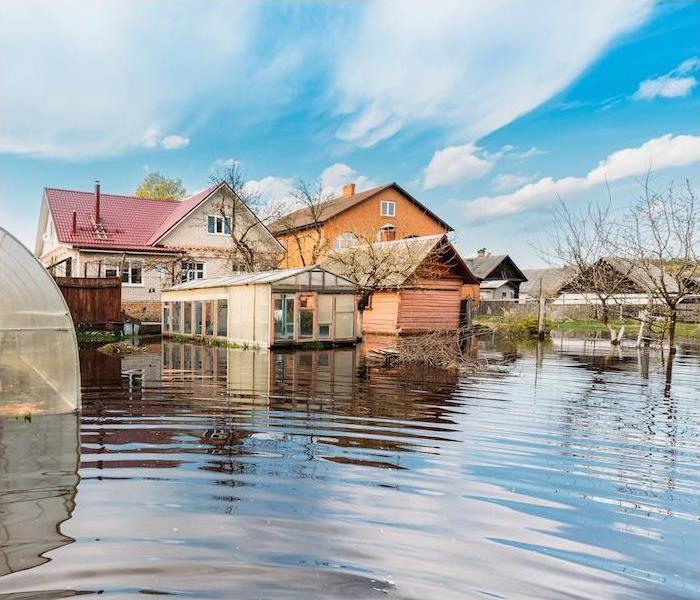 Experienced water damage in your home? Call SERVPRO of Billings to get the restoration process started right away.
Experienced water damage in your home? Call SERVPRO of Billings to get the restoration process started right away.
Regardless of where you live, it is important to make sure you are protected from floods. As little as an inch of water can cause damage and cost any property owner quite a bit in repairs.
If you do not live in an area that has frequent flooding, you may not qualify for a lot of financial help through insurance or other sources. This means that every preventive measure you can take is crucial.
Flooding is a fairly common occurrence for us in Billings and our surrounding areas. In the warmer seasons, the rivers around us are consistently challenged by heavy rains. This makes it essential to know your risks so that you can properly prepare your home and ensure your family’s safety.
Protecting Your Home From the OutsideFlooding cannot always be anticipated with a great deal of time to prepare. Pop-up storms can dump huge amounts of water in a short amount of time that causes puddles to form around your home and overwhelms your gutter systems.
Protecting your home starts with preparing from the outside.
Clean gutters are crucial in ensuring water flows away from your home. With the heavy rains we can frequently experience in June and July, adding an extended downspout to your gutter system could be helpful to prevent overflow and puddling.
You can also use landscaping to protect the bottom level of your home. Gardens pull water down into soil and roots, which means heavy rains are absorbed faster and puddles are avoided.
Organic materials like mulch are also helpful when added to the area immediately outside of your home. Create a slope with these materials to force water away and avoid wet basements or bottom floors.
There are a few upgrades you can consider to protect your home in extreme weather as well, including elevating electric outlets and anchoring fuel tanks if you use one. While those may seem like high-end additions, adding an inexpensive rain barrel that catches water directly from one of your downspouts can be a helpful way to prevent water gathering. And bonus: It means saving money when you water all your beautiful plants!
Flood Protection From the InsideTwo of the best ways to protect the inside of your home are sealing your basement and tackling any cracks in your foundation.
A sump pump in the basement that kicks in when water enters can also be a helpful tool in keeping your home dry. If you live in a high-risk area, a battery-operated pump might be the best idea so you are ensured it will work even if the power goes out.
For flooding that doesn’t start outside, there are a few ways to protect your home with basic home maintenance.
Plumbing is one of the biggest sources of water damage inside the home, particularly pipes that are aged or failing. If you have a leaky faucet, get it fixed quickly and make checking all of your plumbing a regular habit so that other leaks don’t start.
You can also consider adding a leak sensor that will tell you if water is suddenly somewhere it shouldn’t be. Home security systems will sometimes offer this as an add-on or upgrade, so if you were considering having a new system put in, spring for this addition and rest a little more peacefully.
No matter where it comes from, water will damage paper goods and photographs immediately. Store irreplaceable items on high shelves or in a water-tight container.
Make sure you also know where your emergency contacts are stored, and consider adding SERVPRO to the list. The faster you call us, the sooner your recovery starts.
Experienced water damage in your home? Call SERVPRO today to get your restoration completed faster.
Faster to your Yellowstone County Water Damage Event
7/18/2022 (Permalink)
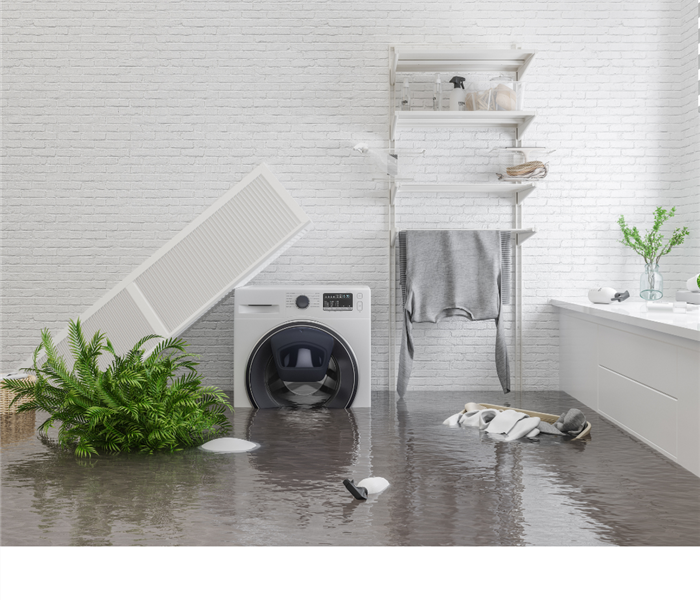 SERVPRO of Billings provides 24 hour fire and water damage restoration service in Yellowstone County
SERVPRO of Billings provides 24 hour fire and water damage restoration service in Yellowstone County
Flooding and water emergencies don’t wait for regular business hours and neither do we. SERVPRO of Billings provides emergency cleaning and restoration services 24 hours a day, 7 days a week—including all holidays.
Faster To Any Size Disaster
Flooding and water damage is very invasive. Water quickly spreads throughout your home and gets absorbed into floors, walls, furniture, and more. SERVPRO of Billings arrives quickly and starts the water extraction process almost immediately. This immediate response helps to minimize the damage and the cleaning and restoration costs.
Need Emergency Service? Call Us 24/7 – 406-252-0859
Water Damage Timeline
Within Minutes
- Water quickly spreads throughout your property, saturating everything in its path.
- Water is absorbed into walls, floors, upholstery, and belongings.
- Furniture finishes may bleed, causing permanent staining on carpets.
- Photographs, books, and other paper goods start to swell and warp.
Hours 1 - 24:
- Drywall begins to swell and break down.
- Metal surfaces begin to tarnish.
- Furniture begins to swell and crack.
- Dyes and inks from cloth and paper goods spread and stain.
- A musty odor appears.
48 Hours to 1 Week:
- Mold and mildew may grow and spread.
- Doors, windows, and studs swell and warp.
- Metal begins to rust and corrode.
- Furniture warps and shows signs of mold.
- Paint begins to blister.
- Wood flooring swells and warps.
- Serious biohazard contamination is possible.
More Than 1 Week:
- Restoration time and cost increase dramatically; replacing contaminated materials and structural rebuilding may be extensive.
- Structural safety, mold growth, and biohazard contaminants pose serious risks to occupants.
About SERVPRO of Billings
SERVPRO of Billings specializes in the cleanup and restoration of residential and commercial property after a fire, smoke or water damage event. Our staff is highly trained in property damage restoration. From initial and ongoing training at SERVPRO’s corporate training facility to regular IICRC-industry certification, rest assured our staff is equipped with the knowledge to restore your property.
How Water Damage Worsens Over Time
4/27/2022 (Permalink)
 No matter the damage sustained, SERVPRO of Billings has the tools and team to help your home return to a normal state quickly.
No matter the damage sustained, SERVPRO of Billings has the tools and team to help your home return to a normal state quickly.
A dripping faucet or a little water spot may not seem like a big deal, but you should never underestimate the amount of damage moisture can cause. On average, a household leak can lose up to 10,000 gallons of water per year.
Water moves quickly and damages most everything in its path, including floors, walls and any soft surfaces. Response time matters, and the faster an issue is addressed, the better your results will be. Here is a timeline of water damage and what you need to know to mitigate it.
In the First 24 HoursThere is a one in four chance that your household will experience flood damage within 30 years of living in a high-risk area. Knowing what to do once you have spotted water is essential.
The first two days after water damage or flooding occurs are crucial. Some items in your home will fall victim to destruction immediately.
Upholstery and other soft furnishings absorb water and become soaked through, while wooden structures can swell from moisture. Personal belongings like photos and books are susceptible to warping and other damage rendering them ruined. Mold can also begin setting up within the first 24 to 48 hours. Quick action can start to limit damage and save your property.
SERVPRO wants to restore rather than replace your personal items, saving you money. Any materials that cannot be restored will be communicated to you and we will handle any required removal in order to continue the drying process.
Within the First WeekAfter the first 24 hours have passed, water damage progresses quickly. The spread of mold takes off like wildfire in an environment with excessive moisture. Mold can even set in to the very structure of your home or business.
In addition to the mold spread, any porous surfaces like wood or walls become more and more compromised while metal surfaces start corroding.
After One WeekMoisture should not be allowed to sit for any length of time as the effects could be irreversible and catastrophic. As time passes, restoration cost and efforts increase greatly, while the risk and damage to structures gets worse.
How SERVPRO Will HelpOur restoration process begins the moment you call us, hopefully within the first 24 hours of water intrusion. SERVPRO generally begins our service with a complete extraction of water. This stops the spread of water within your home and reduces overall drying time.
Once the majority of the water is removed, our highly trained team will use industry-leading drying equipment to remove unseen water. Floors, furniture and other belongings will likely require cleaning, sanitizing and deodorization.
After these steps are finished, construction work may be required in order to restore your home or business back to preloss condition. This could mean minor repairs or the complete rebuild of an entire area.
SERVPRO is a full-service restoration company that can simplify your recovery by completing each step required to get you back in your home faster. We will keep you aware of each step’s progress and let you know the moment you can get back to normal.
Regardless of the type of water damage sustained, SERVPRO has the tools and teams to help your home or business recover. Contact us 24⁄7 when you need a dependable team to help you recover.
How to Clean Up After Your Business Is Flooded
3/7/2022 (Permalink)
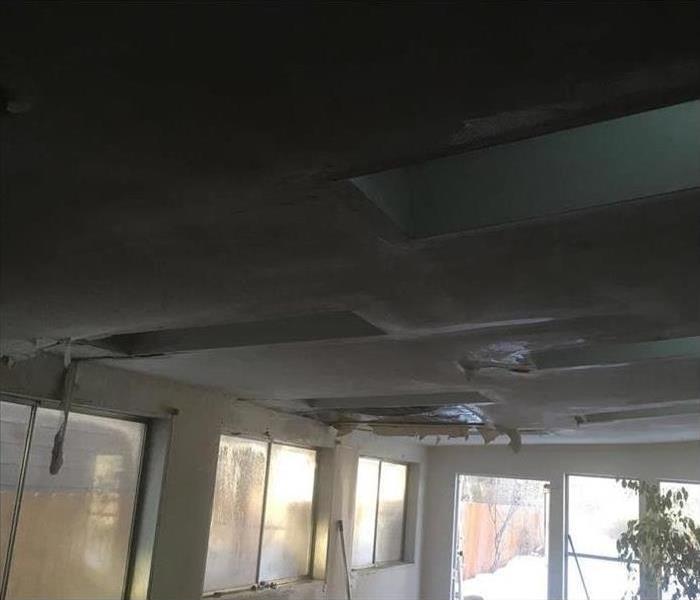 Water damage in Acton, MT.
Water damage in Acton, MT.
Cleaning Up a Flooded Company
Water damage to businesses in Acton, MT, is a big deal. Cleaning up a flooded company is a complex procedure with four main components:
- Steps for safety
- Steps during the flood
- Steps after the flood
- Steps for cleanup
Unfortunately, it’s common for managers and property owners to skip over some of the recommended strategies. However, if you follow this simple plan, you’ll save yourself a huge amount of stress and possibly thousands of dollars.
Step One: Get Out
If floodwaters are approaching, shut off the electricity and gas if you can safely do so. If you have advanced warning, remove anything you can, especially porous personal items. However, don’t waste time if the water is approaching. If it’s a broken pipe spewing clean water, it won’t have toxic elements, especially if you shut off the water quickly.
Step Two: Stay Out
Never enter a flooded company! Floodwaters are considered a major hazard since sewage and chemicals are often mixed in. Also, the water can eat away the dirt below the foundation and cause major structural damage which could collapse the building.
Once the flood has happened, do not reenter until a professional flood restoration company has approved reentry. They can also help with insurance and the cleanup.
Step Three: Get the Water Out
After a big flood, everybody in the area will call the flood restoration companies. As soon as the water reaches your business, you should call your flood restoration professionals to get the fastest service.
You need to get the water out as fast as possible. Every hour the floodwater sits in your building, it’s eating away at materials. Professional restoration companies have special air movers that squeeze the moisture out of your building.
Step Four: Get the Damage Out
Porous materials, such as drywall and carpet, must be removed immediately. The area behind walls and any crawlspaces must be inspected. Washable fabrics can be cleaned by you, although some require dry cleaning.
A flooded company is always a disaster. However, following these simple steps can help mitigate the damage and get you reopened much more quickly.
How to Restore Your Furniture After Water Damage
2/28/2022 (Permalink)
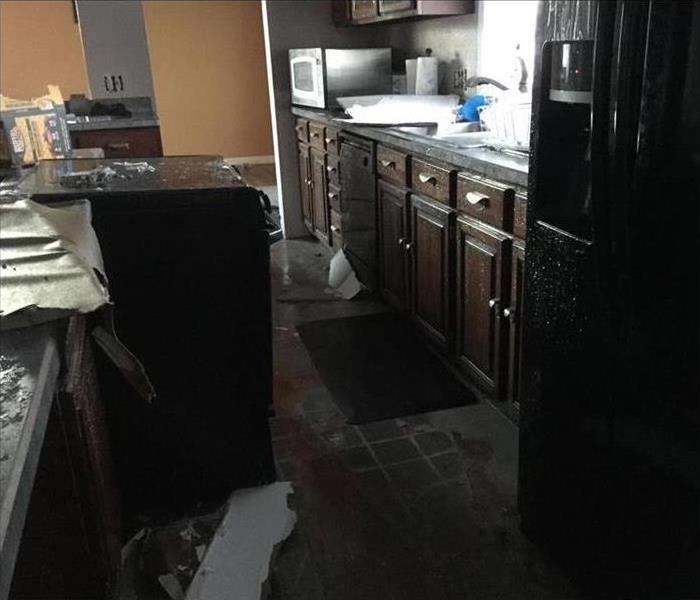 Water damaged kitchen.
Water damaged kitchen.
What to Do If Your Furniture Has Been Damaged by Water
You probably know that water in a home in Comanche, MT, can cause considerable damage to the floors and walls. However, it can also cause problems with the belongings that were in the flooded room. Porous furniture and other items in the room where the flood occurred require special care. This includes:
- Mattresses
- Couches
- Blankets
- Pillows
- Pet bedding
- Upholstered chairs
- Rugs
- Other cloth items
Because these belongings allow air and water to pass through the surface, they can be breeding grounds for mold. After the water in the home is gone, you can focus on the furniture. Avoid having to toss your upholstery by doing these three things.
Remove Visible Mold
Before you can accomplish anything else, you must get rid of any mold you can see. If you can use a HEPA vacuum, do that and then throw away the bag when you are finished. However, if you can’t get your hands on such a tool, you can wear gloves and wipe the mold away with damp paper towels. Make sure to seal the dirty paper towels in a plastic bag before you throw them away.
Air Dry
If the upholstery is still wet, allow nature to work in your favor as much as possible. If you can allow something to dry outside in the sun, do let it sit outdoors. If not, you can open the windows and doors. If the weather doesn’t allow for these methods, you can use a dehumidifier in the room.
Clean with Alcohol
Once the furniture finishes dry cleaning, you can use a one-to-one solution of rubbing alcohol and water to finish the restoration process. First, wipe away any remaining mildew you find. Then, dampen a cloth with the alcohol solution and rub it on the furniture. Make sure to allow it to dry completely.
Water in a home can be a nightmare for any homeowner. However, a professional cleanup crew can help you restore your home in Comanche, MT, and you can use these tricks to get your furniture back to normal.
Flood Damage: How Much Does Insurance Cover?
1/25/2022 (Permalink)
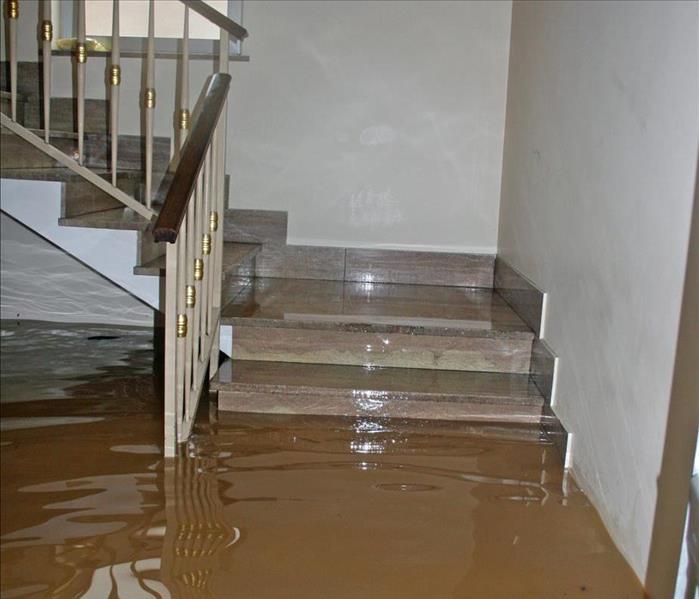 A flooded home in Billings, MT.
A flooded home in Billings, MT.
How Much Does Insurance Cover Flood Damage?
If you ask your insurance agent if your homeowner’s policy covers broken pipes, he or she is likely to say that it doesn’t. While the actual repair of the pipe is considered a home maintenance cost, however, the flood and subsequent water damage it causes probably do fall under your coverage. You can file a claim for the cost of water restoration services under most circumstances that involve broken pipes.
Potential Damage
You will probably have to pay to fix the broken pipe out of pocket. Repairing or replacing the items it damages, however, likely falls under your insurance policy. Water from a bursting pipe can damage:
- Ceilings
- Hardwood floors
- Carpet
- Cabinets
- Walls
- Insulation
As long as you call experts to remedy the damage as soon as you find it, it should be covered by your insurance. If you don’t understand your coverage, your insurance agent can explain exactly what events fall under its requirements. There are several circumstances, however, that may cause your claim to be denied.
Potential Denial
A flood that occurs as the result of your own negligence will probably be denied coverage under your homeowner’s policy. For example, if inspectors discover that the pipe has been leaking water for a long time, the delay in repair could be a reason the insurance company cites for denying your claim. If your pipes freeze because they are not properly insulated, that could also be a cause for denial. If flooding involves rising water, the damage may be too extensive to fall under your general policy. You may have to rely on extended insurance coverage for those damages to be paid for.
The insurance for your home in Billings, MT, serves to protect you when a flood occurs. Timely reporting is vital for fast compensation. The sooner you arrange for repairs and file your claim, the more likely you are to be covered.
How To Prevent Water Damage When You’re on Vacation
12/31/2021 (Permalink)
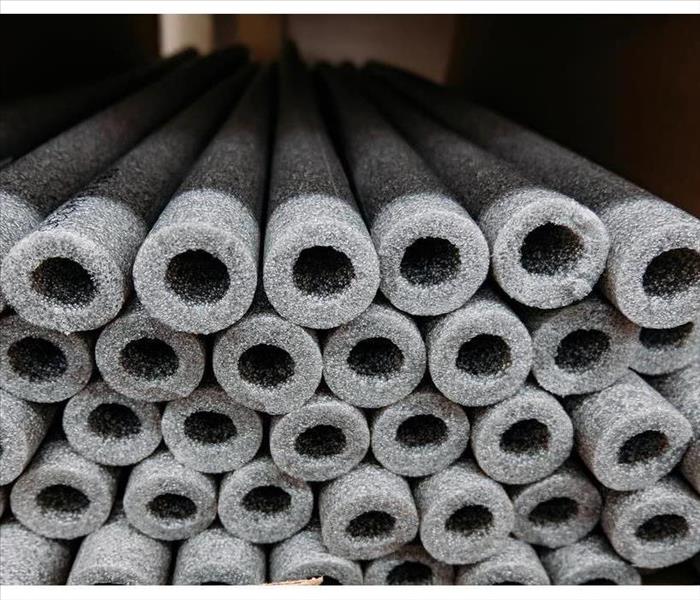 Insulate your pipes.
Insulate your pipes.
When You're On Vacation, Here's How To Avoid Water Damage
Nothing ruins a great family vacation faster than coming home to a flooded house and an emergency water pipe repair. There’s not much you can do about coastal storm surge or an overflowing river, but there are many types of flooding you can prevent. With a little bit of planning and forethought, you can reduce your chances of needing to call a water damage mitigation specialist in Broadview, MT, your first night home.
1. Have Your Plumber Do a Maintenance Check
You don’t have to wait until there’s a crisis to have a professional check your pipes and supply lines. A plumber can tell you about any potential problems so you can deal with water pipe repair and upgrades before you leave.
2. Insulate Your Pipes
If you expect freezing temperatures at home while you’re away, insulate your pipes. This prevents them from freezing and bursting while you’re gone. Focus on pipes in uninsulated parts of your home that are likely to be exposed to outside temperatures.
3. Turn Off Your Water
You can also turn off your home’s water supply at the main. Then open up all the water taps in your house and let them drain. This ensures you won’t have any plumbing-related floods while you’re gone.
4. Clean Your Gutters and Drains
Make sure to clean your gutters, drains and downspouts before you leave town. That way if there are heavy rains in your absence, the water will be directed away from your home. This makes leaks less likely.
5. Back Up Your Sump Pump
If there’s a power outage during a storm, your sump pump may not be able to handle a rising water table. By connecting your sump pump to a backup generator or getting a battery-powered pump, you can avoid coming home to your basement under water.
Taking the time to prep your house before you leave on vacation can save you from coming home to an emergency water pipe repair. While a water damage mitigation specialist in Broadview, MT, can handle the cleanup if the worst occurs, it’s better if you don’t have to call for help.
Basement Floods: 4 Common Causes
11/18/2021 (Permalink)
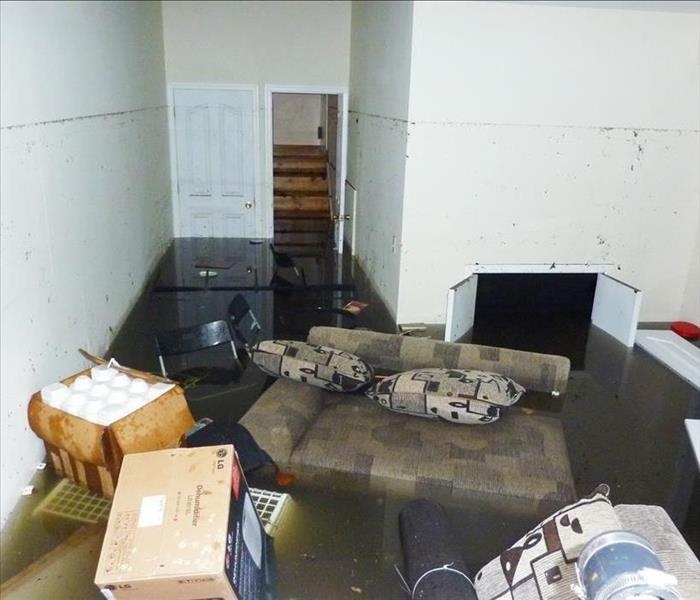 Flooded basement in Billings, MT.
Flooded basement in Billings, MT.
Basement Floods
A basement flood may be on the top-ten list of most homeowner’s nightmares, but while it is worrisome, it may also be preventable with routine maintenance and inspection. Granted, no amount of preventative action will result in a definitive defense, but it can diminish the risks exponentially. If you want to protect your basement, then watch out for these four most common problem areas.
1. Improper Sealant
Water damage does not always have to be caused by a significant issue. Surprisingly, the improper use or inadequate coverage of sealant can allow moisture to seep into your basement causing a consistent water problem. Thankfully, you can get kits and products to seal your basement yourself.
2. Blocked Gutter
Another common cause of a basement flood is a clogged gutter. The consensus is that gutters need to be cleaned a minimum of five times per year. Regular maintenance of gutters and downspouts can ensure that rainwater is directed away from the foundation of your house rather than overflowing the eaves and flooding your basement.
3. Failed Sump Pump
Failed sump pumps can also lead to a flooded basement. Sump pumps, like any other appliance, require routine maintenance to function correctly. Cleaning out filters, checking on suction and inspecting power regularly can help prevent many sump pump malfunctions.
4. Clogged Drain
A clogged drain can be the most common cause of flooding because it disrupts the natural flow of water, forcing the liquid to either backup or exert excess pressure on the pipe, leading to leaks or pipe breaks. If you notice a drain is not functioning normally, you may want to snake the drain yourself or have a professional from the Billings, MT, area check it out for you.
A basement flood may be a nuisance and can be damaging. While many of the most common issues can be resolved quickly without going to significant expense, the problem with flooding in this type of area is that not everyone notices the issue right away. Routine maintenance and even inspection of common problem areas may be necessary to prevent significant costs later.
3 Common Water Issues in Commercial Buildings
9/18/2021 (Permalink)
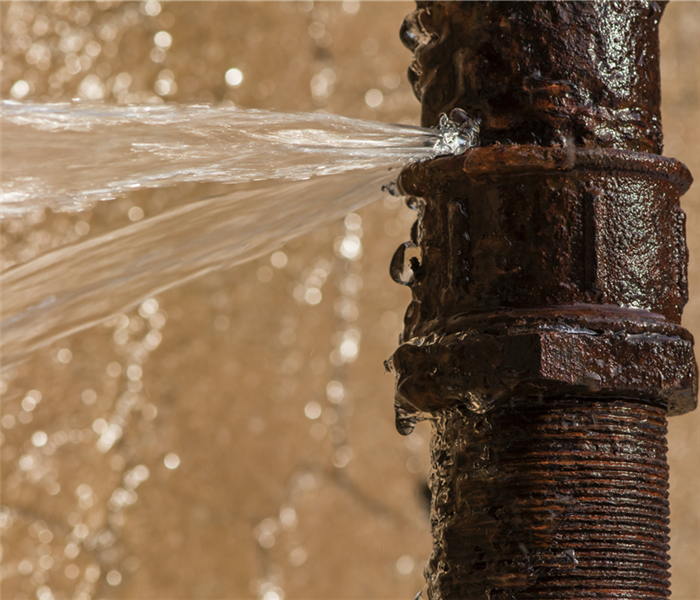 As a business owner, you know the value of having a clean, safe business.
As a business owner, you know the value of having a clean, safe business.
Managing a business takes a great deal of time, energy, and money, but the payoff can be rewarding. Unfortunately, water issues such as leaking pipes can force a business in Billings, MT, to close its doors. Knowing the common water issues that many businesses face can help you prevent water damage to your business.
1. Damaged Pipes
Pipes can become damaged over time, which can result in a break or leak. Both issues can cause long-term damage to your business. If your pipes are leaking, you may notice that your water bill has increased without an increase in purposeful water use. A pipe break is often more sudden and apparent, but it can also cause extensive damage. Maintaining your business’s pipes will help prevent leaking pipes and other damage from occurring.
2. Sewer Backup
If your building has repeatedly had a toilet back up or you notice the water isn’t draining appropriately in sinks and other drains, it could be a sign of a sewer backup. Sewer backups can leave your business without functioning restrooms and appliances, and they can also be dangerous to people’s health. Backups can create water damage in a variety of locations in your business and can affect various appliances at once.
3. Foundation Damage
A sturdy, supportive foundation is essential for any building, including businesses. If water has accessed your business’s foundation numerous times, especially in older buildings, the foundation may begin to crack. It’s important to be aware of the state of your building’s foundation since damaged foundations can make a building unsafe to inhabit. Signs of foundation damage could include visible cracks, sinking floors, and doors that won’t easily open or close.
As a business owner, you know the value of having a clean, safe business. Water issues such as leaking pipes can wreak havoc on a business, but knowing what to look for can help you keep your business functioning at its best. If you do experience water issues, qualified professionals can help you fix the issues and prevent future damage.
How To Handle a Leaking Sink
7/15/2021 (Permalink)
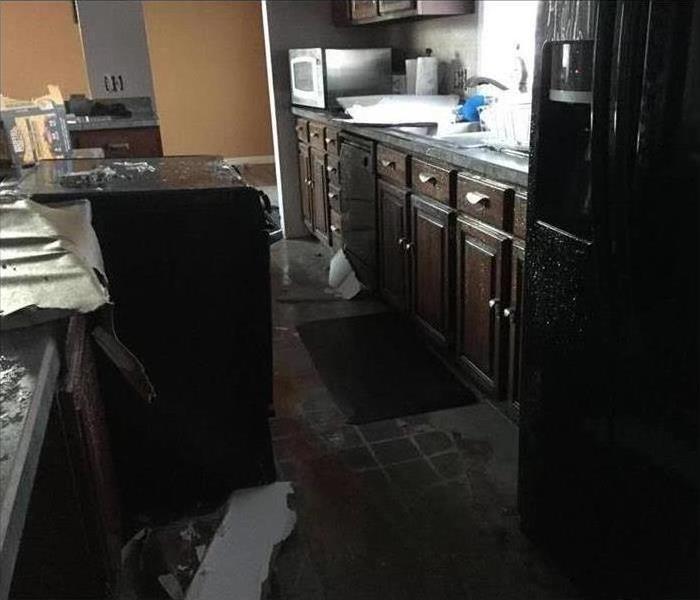 Water damage on a kitchen in an Acton, MT home
Water damage on a kitchen in an Acton, MT home
How To Handle a Leaking Sink
You open the cabinets under the kitchen sink at your home in Acton, MT. Suddenly, you notice a puddle. Before your eyes, the small puddle turns into flooding. As you watch the water in your home spread, what is the next step? Mitigate the Damage
Even if you do not know anything about pipe or kitchen repair, there are a few steps you can take before help arrives:
Safety should be your first priority. If possible, shut off the main water valve to stop the flooding from continuing. Make sure that you do not stand in water when active electricity is nearby. Also watch your step carefully, as wet kitchen floors are slippery. If you have any doubt about your wellbeing, leave the house and wait for a professional to assess the situation.
Once the water in the home has ceased from spreading, remove items from the waterlogged area. Use a mop or towel to soak up excess water. Open windows or use air conditioning to circulate the air. Do not use electrical appliances or attempt to vacuum up the water.
Call for Help
Oftentimes a kitchen flood causes significant water damage, which can spread to the adjacent rooms in your home. When not dealt with quickly, secondary damage can occur such as mold. Make the following phone calls as soon as possible:
Contact your homeowner’s insurance agent. When a pipe bursts, insurance typically covers the resulting water damage.
Call a reputable water restoration specialist. After your property is inspected and safety issues are resolved, the company gets to work on removing pooled water, drying the space with industrial equipment, cleaning the area and completing the kitchen repair.
When you discover your kitchen flooding in Acton, MT, immediately begin to mitigate the damage by stopping the water source. Partner with your insurance agent and a water restoration company to return your kitchen to pre-flood condition.
How Water Damage Affects Building Materials
3/12/2021 (Permalink)
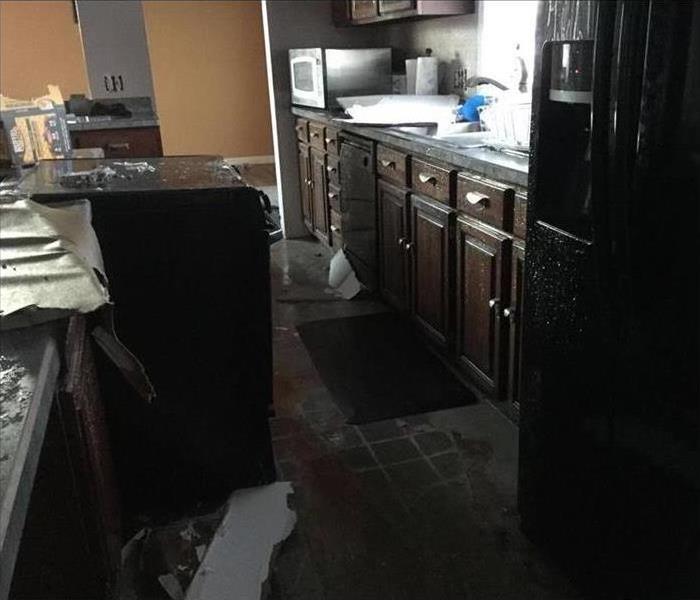 Water damage in a kitchen.
Water damage in a kitchen.
How Water Damage Affects Building Materials
From swelling wood to crumbling drywall, water damage can have different effects on various building materials. Composition is an important consideration, as some substances are ruined by becoming wet and will need to be torn out and replaced. Other materials may be dried and restored. Find out more about the effects of water damage on building materials at a home in Comanche, MT.
Porous Materials May Be Ruined
Absorbent or porous materials soak up water, and the level of contamination in this water will determine whether materials can be dried or require disinfection. Here are the three categories of water damage:
- Category One damage involves clean water
- Category Two damage involves contaminated water
- Category Three damage involves grossly contaminated water
Some porous materials, such as carpet soaked by water from a broken supply line, may be quickly dried. Water pipe repair may be all that is necessary to resolve the cause of damage. Appliance leaks, roof leaks or flooded showers or toilets may expose contents to chemicals or microbes. This Category Two damage requires disinfection. Category Three damage caused by a sewer backup requires disinfection or disposal of materials that are difficult to disinfect.
Wood Becomes Likely To Swell
Wood swells and becomes distorted after exposure to water. Cupping occurs when more moisture is absorbed by the unfinished underside of swelling wood, which expands more than the top. It may be possible to dry and refinish or replace flooring or fixtures.
Metal May Corrode Over Time
Some types of metal undergo a chemical reaction when exposed to water and air that could undermine the integrity of structural materials. It may be necessary to replace damaged components.
It is always important to mitigate water damage as quickly as possible. Start by extracting any standing water at a residence in Comanche, MT. Restoration specialists can recommend the best treatment for swelling wood.
4 Steps for Preparing a Business Interruption Claim
2/16/2021 (Permalink)
 Business interruption insurance is one source businesses rely on when they experience disasters.
Business interruption insurance is one source businesses rely on when they experience disasters.
4 Steps for Preparing a Business Interruption Claim
If you have recently had to hire water remediation professionals to clean up the flooding in your business, you know the importance of filing a well-documented claim with a business interruption insurance company. Here are a few steps you can take to ensure your claims are thorough and don't get subject to extensive reviews and rejection.
1. Develop a Plan
The key to starting a sound claim is creating a team responsible for handling your flooding. You should then thoroughly review your insurance policy and determine if the event is covered, unlike a broken pipe due to freezing temperatures. If you have experienced a covered peril, you should contact your insurance adjuster and start the claim process.
2. Measure Your Income Loss
You need to measure your income loss in an objective and supported way. Also, ensure that you take any normal operating expenses out of your total income. Some areas that require thorough support include the relationship of the loss to a disaster, your ordinary income, your income history, any market conditions that could impact these numbers, and the sales you have used to offset your losses.
3. Identify Any Extra Expenses
In addition to lost income for your business in Laurel, MT, you will likely be able to get funds to pay any extra expenses that are a direct result of a disaster. For instance, a flood will bring cleaning and disinfecting fees that you would normally not have to pay.
4. Execute a Mitigation Plan
Your insurance adjuster will focus on the efforts you took to mitigate your interruption after the flooding. This could include many different tactics, such as moving to a temporary location, finding alternative suppliers, or reaching out to customers through unusual methods. Make sure your loss mitigation plan is well documented so you can offer it to your insurance company.
Business interruption insurance is one source businesses rely on when they experience disasters, such as large water damage. To ensure their claim is accepted quickly, business owners should follow these critical steps to create a strong and well-supported case.
2 Things to Look for to Tell if You Need to Replace Your Carpet
1/15/2021 (Permalink)
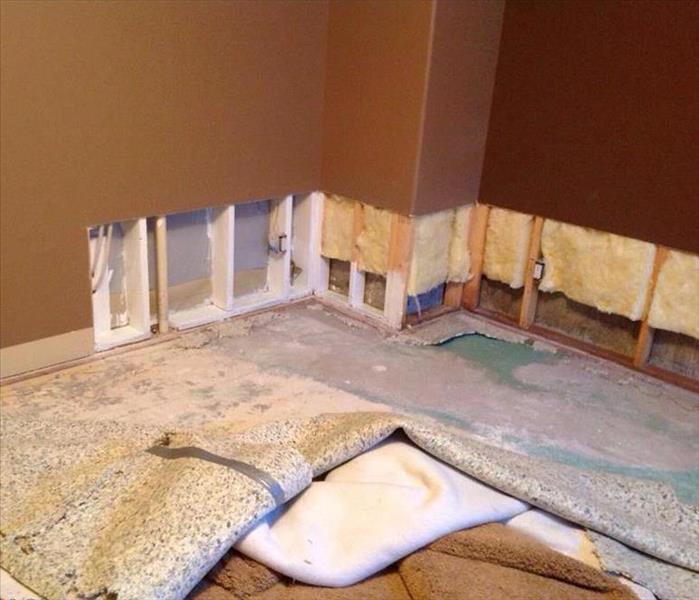 It's hard to know exactly when to replace your carpet
It's hard to know exactly when to replace your carpet
Read on For Some of The Most Obvious Signs
Carpets can be around for a long time. Some can last a lifetime. The key is to take care of them. Even so, they will be subject to fading over time. Obviously, many carpets see incidents, like a pipe break, and do not last that long. Others show their age through rips and stains.
When you look at your rug in your home in Acton, MT, you may wonder if it needs to be replaced. More importantly, you will probably wonder how you'll know when to replace it. Don't worry. There are a few fairly obvious signs. They can tell you if you need to replace your rug.
1. Stains
You can hide a small stain under your sofa. You shouldn't have to scramble to cover up the stains from your last pipe break. This is true if the remediation company that repaired the damage recommended new flooring. They will likely recommend this because water damage can lead to mold.
New carpets often have a stain barrier. However, this can fade over time and leave your rug vulnerable. This is true for any spill, such as pet urine. Oftentimes, trying to remove stains at home can make them worse. This is true if you are using homemade or store-bought cleaners. Additionally, these spills will likely cause the liquid to seep deep into the carpeting. In other words, if you have a lot of stains, it is time to replace your rug.
2. Rips
A catastrophe, like a pipe break, can lead to rips as well. If there are small rips, they will likely not be replaced during your restoration, so you will need to replace the rug on your own.
It's hard to know exactly when to replace your carpet. If you take care of it, it can last for a long time. However, if it has many stains or rips, it should be replaced as soon as possible.
4 Steps for Fixing a Flooded Basement
11/20/2020 (Permalink)
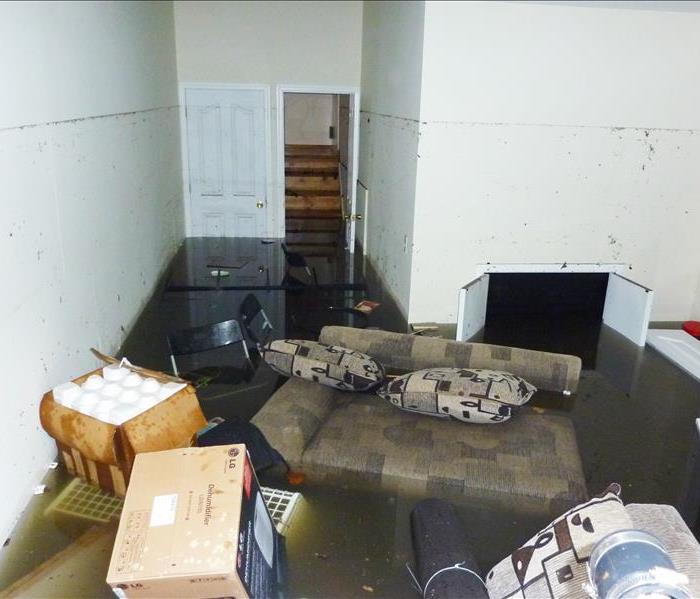 A basement flood will not sink you when you know what to do and who to call for help
A basement flood will not sink you when you know what to do and who to call for help
What To Do About It?
When a homeowner finds water in their basement, it brings up a lot of questions including what to do about it. Here are four steps to help you wade through a basement flood.
1. Get the Water Out Safely
The first step to dealing with a flooded basement is to remove the water. However, make sure you can do it safely. The water could be contaminated, so if you cannot find the source, stay out of it. There is also a chance that the water has come in contact with your electrical system and could electrocute someone.
If there is a small amount of water, you can use a wet/dry vacuum or rent a pump to clean it up yourself. Large amounts of water, or water with no clear source, should be handled by a removal expert.
2. Remove Affected Objects
Remove anything that came in contact with floodwater. Do not test appliances or any electronics to see if they work, even if they appear undamaged. Remove any fabrics and other fibers. These materials hold moisture and are ideal places for mold spores to settle and grow.
3. Call Your Insurance Agent
Knowing your insurance coverage is important when it comes to flooding. Not all cases are covered. If the damage is due to a burst pipe, then the accident is likely covered under your home insurance. However, if the flooding is due to severe weather, it may not be covered. Take high-resolution photos and thoroughly document the incident to make filing a claim easier.
4. Call a Professional
It is always good to get a second opinion from a water damage specialist after a basement flood. An expert can assess the situation and help you develop a plan for dealing with the aftermath and cleanup.
A basement flood will not sink you when you know what to do and who to call for help in your hometown of Billings, MT.
How to Repair a Leaky Toilet
10/9/2020 (Permalink)
 A leaking toilet can potentially cause catastrophic amounts of water damage if not properly repaired
A leaking toilet can potentially cause catastrophic amounts of water damage if not properly repaired
A toilet is typically a very durable and sturdy household fixture that should, ideally, last for multiple decades. That being said, even the best toilets are subject to leaking from time to time. If your home in Billings, MT, has a leaking toilet, follow the steps below.
Step by Step Toilet Repair
Luckily, repairing a leaky, old toilet is a relatively easy process, even if you don't have any plumbing experience.
Use a wrench to disconnect the supply tube from the shutoff valve. Double-check to make sure all the water is drained from the bowl and tank.
At the base of the toilet, remove the caps that cover the closet bolts. Remove the hex nuts using a wrench.
Grasp the toilet by the bowl and very carefully lift it up using your legs. Set the toilet down on an old blanket or cardboard sheet to avoid causing water damage to your bathroom tiles.
Scrape the old wax gasket off from the closet flange. Inspect the closet flange for damage. In most leaking toilet cases, a section of this flange is broken off.
Loosen the screws that secure the closet flange to the bathroom floor. Slide a repair strap underneath the flange.
Center the new wax gasket over the closet flange. Both closet bolts should be in place.
On the bottom of the toilet's tank, connect the new water supply tube to the threaded fill-valve shank.
Apply downward pressure on the rim of the toilet bowl to compress the gasket. Tighten each closet bolt and then apply more pressure.
Trim the tops off the closet bolts using a close-quarter hacksaw. Tighten the nuts and replace the caps.
Reconnect the supply tube to the shutoff valve. Open the valve and flush the toilet. Carefully inspect for leaks.
A leaking toilet can potentially cause catastrophic amounts of water damage if not properly repaired. Contact water remediation experts for additional help if the above technique does not remedy the issue.
5 Common Commercial Building Sewer Problems
8/31/2020 (Permalink)
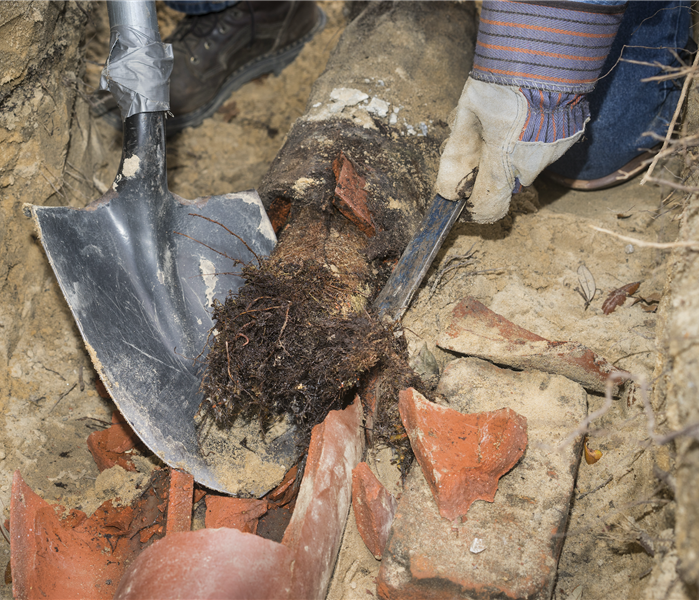 Tree roots will invariably find your sewer system
Tree roots will invariably find your sewer system
Commercial Building Sewer Problems
Your building’s biggest drain is its sewer line. Major problems can occur as a result of a damaged or blocked sewer line. These issues can wreak havoc on a commercial building if they aren’t discovered and solved early on. Beware of the following potential problems.
1. Substances Building Up
Never put grease down a drain; it’ll solidify and build up in the pipes. Coffee grounds are also one of the worst substances for a drain.
2. Foreign Objects Getting Stuck
Sanitary sewer lines and bathroom drains — both residential and commercial — are designed to handle only human waste and toilet tissue. Nothing else should be put down the drains. Even paper towels and “flushable wipes” are harmful to septic systems.
3. Tree Roots Growing
In their search for moisture and nutrients, tree roots will invariably find your sewer system. They’ll even grow into the line by infiltrating cracks that develop in the pipes. This can cause serious problems such as pipe breaks, as well as leaking or blocked sewer lines. A toilet overflow is often the first sign of a sewer blockage.
4. Lines Failing
Freezing and thawing cycles in the ground, shifting soil, tree roots or the settling of a structure can cause pipe breaks, cracks or collapse. When damaged sewer lines leak, the water will saturate the ground surrounding the pipes, causing more damage to the line when it freezes. Piping that isn't made of PVC is at risk of deteriorating and can give way, obstructing flow through the pipe.
5. Pipes Sagging
Over time, parts of pipes will sag deeper into the ground. Water, waste, and sediment will then collect in this “bellied” area and get trapped, blocking the line from flowing properly.
Always be mindful of signs of a leaking or blocked sewer line at your Laurel, MT, building. If a problem occurs, water damage cleanup experts will return your property to its preloss condition as quickly as possible. Prevention is key, so have your sewer line inspected every three to five years.
Staying Safe Around Category 3 Water Damage
5/26/2020 (Permalink)
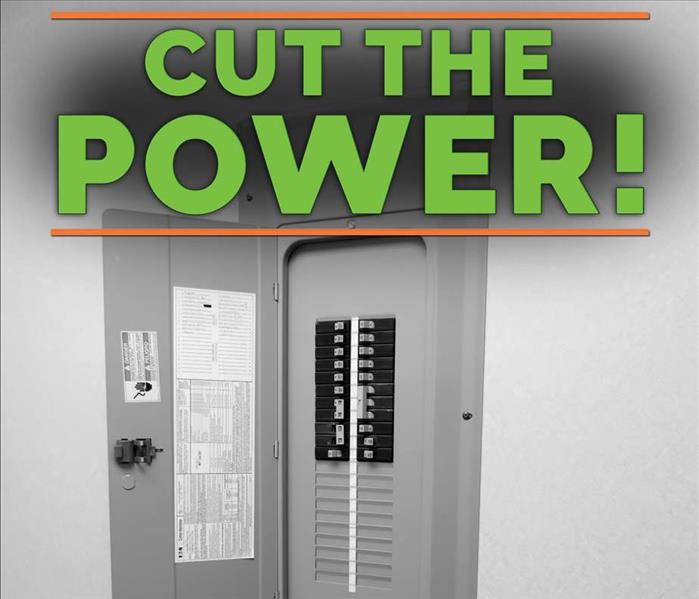 The very first thing you should do before entering any flooded area is to turn off the power to the space
The very first thing you should do before entering any flooded area is to turn off the power to the space
Precautions To Take If You Enter a Flooded Area
A residential category 3 flood, or black water, is the most contaminated floodwater. While it is tempting to remove the water immediately, certain precautions are necessary to secure your property and ensure your safety. If you must enter a flooded area, there are several precautions you should take to protect yourself and your family from additional exposure or hazards.
- Turn off electricity
- Wear protective gear
- Use professionals
Turn Off Electricity
The very first thing you should do before entering any flooded area is to turn off the power to the space, especially if the water level is higher than a few inches. The risk of electrical shock is an actual threat. Even if the power appears out, go to the electrical power and shut it off from there before starting water and sewage cleanup.
Wear Protective Gear
Blackwater doesn't get its name from color alone; it is contaminated with sewage, chemicals, and bacteria. You do not want this water to come into contact with your skin. Wear protective clothing if you must trek through the water, including a full-body suit, face mask, gloves, and a pair of goggles. Contacting or ingesting this water type can make you violently ill.
Use Professionals
Your best bet when dealing with a category three flood is to contact a water mitigation company in Broadview, MT, for help. In fact, some states may require professional removal of the floodwater because of its contamination level. Make sure the company you hire has the proper licensing and certification to work in your state and with your insurer.
Blackwater is the most contaminated flood source, and homeowners should avoid contact with the flood if possible. Contact your local government or insurer if you do not know how to handle the removal and restoration of your property. You may also want to call a restoration company to assess the level of property damage.
How Small Businesses Can Prevent Water Damage
5/11/2020 (Permalink)
 The plumbing in a commercial structure should be inspected by a licensed plumber
The plumbing in a commercial structure should be inspected by a licensed plumber
How Small Businesses Can Prevent Water Damage
Water damage is the second most common cause of small business property insurance claims. Taking measures to prevent damage may enable a business owner to avoid the necessity of making a costly business claim. Here are three ways to reduce the likelihood and severity of damage due plumbing problems at a business located in Billings, MT.
Plumbing Inspection
The plumbing in a commercial structure should be inspected by a licensed plumber on a yearly basis. This process should account for every component in this essential system:
- Pipes
- Fixtures
- Backflow testing
- Visible damage
Plumbers may use cameras or check the water pressure to determine the condition of lines. These measures are helpful for determining when plumbing components require replacement to prevent a pipe break. Fixtures should also be checked for leaks. Backflow testing ensures that wastewater is not contaminating clean water. Any indications of mold, puddles, or water stains around pipes or fixtures indicate underlying problems that require repairs.
Sewer Maintenance
A commercial property insurance business claim will not cover sewage damage. Additional coverage in the form of an endorsement is necessary to offset expenses associated with cleaning up contaminated water and solid waste. Regular use of enzymatic drain treatments and clearing clogs in a timely manner can prevent this costly damage.
Preventative Upgrades
A small business owner may want to invest in a backwater prevention valve to stop sewer backups or replace polybutylene pipes prone to premature failure. These upgrades require planned expenditures, but tend to be more cost-effective than emergency plumbing repairs and water damage restoration.
The average business claim amount for damage caused by water or freezing is $17,000. In the event of unavoidable damage, a well-documented history of regular inspections and preventative maintenance may increase the likelihood that most of the costs of repairing and restoring damage will be covered by a commercial property insurance policy.
Avoiding the Financial Strains of Water Damage
2/14/2020 (Permalink)
 Major water damage in a Comanche, MT home
Major water damage in a Comanche, MT home
Many households across the United States have encountered the dismay of dealing with a broken pipe. More than 90 gallons of water are wasted per day due to leaky pipes, dripping faucets, worn toilet flappers, and similar issues in 10% of homes according to the Environmental Protection Agency. To fix broken pipes at homes in Comanche, MT, consulting a professional is often the best way to minimize further problems.
Water Damage Can Be Costly
The cost of repairing your home after a leaky or broken pipe can be high. This price varies by the type of property and the water damage restoration company hired to take care of the resulting flood damages. Some major examples of resulting damages may include the following:
- Structural damage
- Electrical loss
- Mold formation
- Clogged sewage and drainage systems
Electrical damage is a major deal. For homeowners, this can mean losses in food items and the usage of electrical equipment necessary for heating, cooling or other household functions. Total costs related to major electrical problems such as re-wiring a home are usually high — ranging from $500 to $2100 — which does not include costs to replace or repair any damaged electrical fixtures as a result of water damage.
Peace of Mind Is Secured by Being Insured
The initial panic of dealing with the aftermath of a flood can be overwhelming. Fortunately, the risks of having to pay out of pocket for restoration work are significantly minimized with insurance protection, which covers many water incidents involving broken or leaky pipes. What's more, restorative job rates not only include labor costs but also depend on the materials needed for repairs and electrical device replacements for the property owner. Reviewing the terms of your current insurance policy can ensure that there are no exclusions and that the type of coverage you hold will cover potential damages and/or losses.
A flood in your home can be a very stressful situation. Enlisting the help of a professional restoration company and securing insurance coverage can help mitigate both anxiety and financial strain.
Filing an Insurance Claim for Commercial Water Damage
1/29/2020 (Permalink)
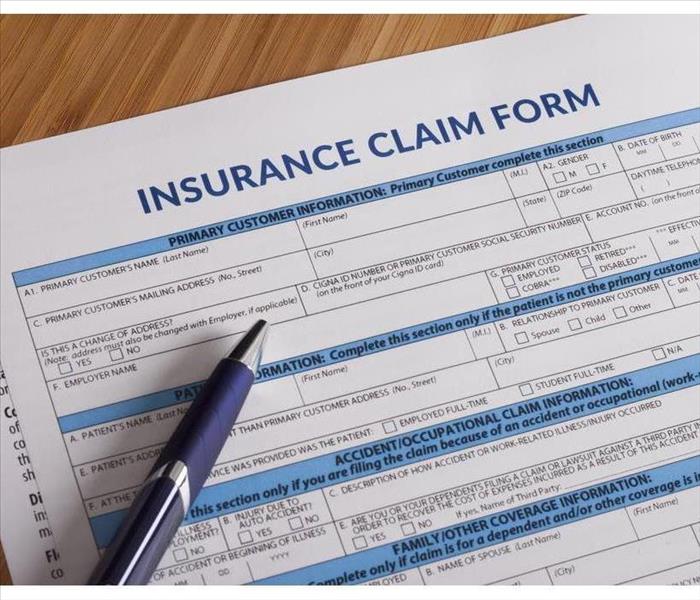 Let us handle the negotiations for you, nobody wants to deal with insurance claims
Let us handle the negotiations for you, nobody wants to deal with insurance claims
If your business property has been damaged by water, you’ve seen how disruptive it can be. Suddenly, you have calls to make, professionals to consult and a cleanup process to organize, all before you can return to your work. This discussion of insurance coverage for water damage may clarify the best way for you to obtain financial assistance with the process.
The source of the offending water will help determine whether you need professional restoration services and what type of insurance will reimburse you for your damage. Damage from internal sources will generally be covered by a conventional business insurance policy, but flooding and other external water sources will usually be excluded.
Conventional Business Insurance Coverage
Most common types of internal commercial damage will be covered by your business insurance policy. If any of the following sources contributed to your property damage, you would consult your insurance agent for water damage coverage possibilities:
- Broken pipes
- Sewer backups
- Leaking toilet or shower
- Leaking appliances
- Stormwater entering above ground level
You may find that insurance policies vary in limits and deductibles between regions. Your agent can outline your coverage details and initiate a claim.
Commercial Flood Insurance
The US government issues flood insurance to cover you for water entering your home from outside at ground level or below. Floodwater generally originates from a severe weather event or a municipal breach, such as a blocked drainage culvert or dam break. Your insurance agent can help you file a flood claim with the government. If you don’t have flood insurance and are in a low-lying area or higher-risk area for water damage, it may be wise to consider it.
If water somehow ended up where it wasn’t wanted in your Broadview, MT, business, your to-do list is likely full of water cleanup and restoration activities. Consulting your insurance agent early on may give you some peace of mind and set you on the path back to business as usual.
What Should You Do About Swelling Wood in Your Home?
12/12/2019 (Permalink)
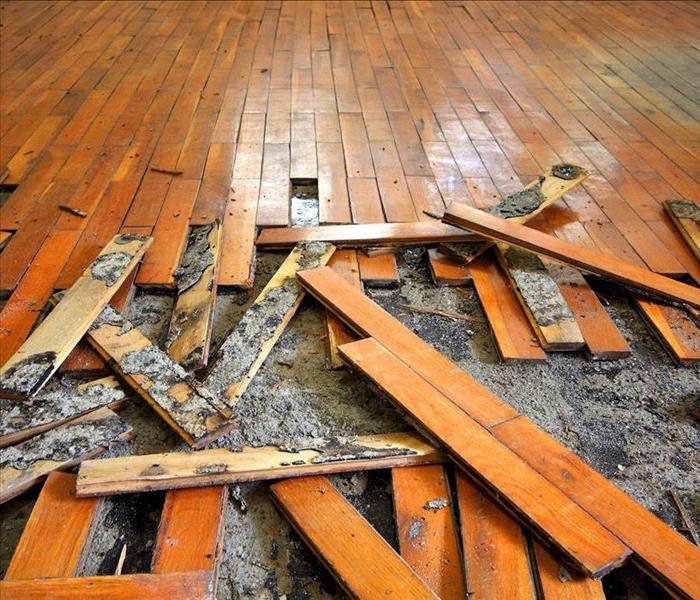 Wood that has begun to swell is usually reacting to a certain change in its environment
Wood that has begun to swell is usually reacting to a certain change in its environment
What To Do With Building Materials That Have Become Swollen
Building materials that are made of wood may begin to swell in response to various factors. In most cases, wood swells in wet or humid conditions, and this effect can become more pronounced after a storm or other severe weather event in your Comanche, MT, area. Before you can begin to address a swelling wood problem, it’s important to understand what may be causing this to happen. These tips can help you determine what to do about building materials that have become swollen.
The Causes
Wood that has begun to swell is usually reacting to a certain change in its environment. These common triggers can lead to swollen wood in your living space:
- High temperatures
- Rain
- Humidity
- Exposure to sunlight
While heat, rain and humidity are factors exclusively controlled by weather and climate, the amount of sunlight that wooden materials receive is directly impacted by their location on your property. For example, wooden doors that are pointed towards the south are exposed to more sunlight than north-facing doors. As a result, the doors may expand in the heat and their finish can become compromised.
What to Do
Once you’ve identified the cause of your swelling wood, you can determine how to take action. Most water-impacted materials can be replaced, including wooden doors, cabinets and furniture. Be sure to remove damaged materials and replace them immediately to keep further harm at bay. Additionally, if the swollen wood is a result of a faulty supply line or pipe, be sure to inspect the affected source and schedule a water pipe repair if necessary.
Any problems that cause water damage to wooden materials in your home should be taken care of promptly. If a buildup of heat or moisture in your environment has led to swelling wood, call for a water damage repair as soon as possible to preserve the state of your living space.
What Types of Water Damage Are Covered by Insurance?
10/14/2019 (Permalink)
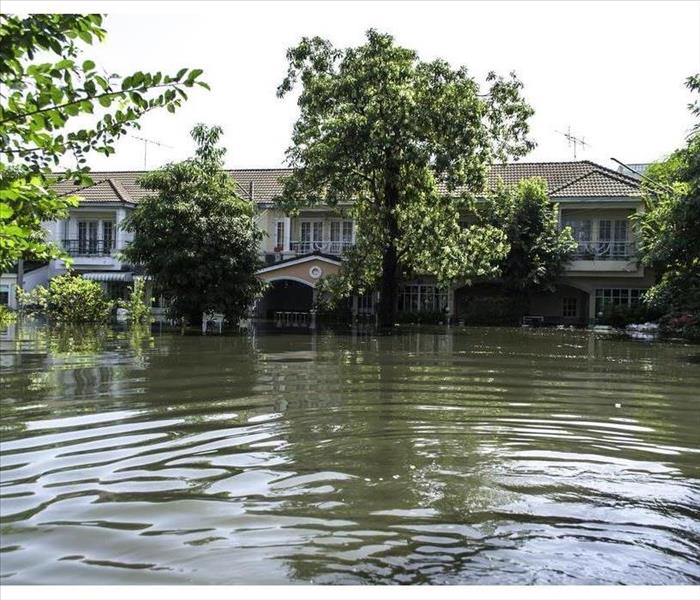 Some examples of flood causing weather are: Rising flood waters
Some examples of flood causing weather are: Rising flood waters
What Types of Water Damage Are Covered by Insurance?
There are myriad ways that water can damage your home in Acton, MT. Whether it is a flood event or a burst pipe, there is cause for concern. What does most insurance cover in terms of water damage?
Resulting Damage
Most homeowners have something called "all-perils" coverage included in their plan. This policy usually covers most resulting damage- the damage that exists as a result of some sort of initial damage. However, you are usually not compensated for the cause of the damage. This means that your insurance wouldn't pay to fix broken pipe the flooded your basement, but it would pay for a water damage remediation company to come in and clean up the flooding, replace waterlogged materials and prevent mold.
Weather Damage
The average home insurance policy doesn't automatically include coverage for weather events. It can be added separately, or as a rider on your current insurance. If your house is located in a designated flood zone, you may be required to add this coverage in order to get a mortgage. Flood insurance pricing is determined by the National Flood Insurance Program. Some examples of flood causing weather are:
- Rising flood waters
- Hurricane
- Heavy rain storm
Negligent Damage
Claims are often denied for negligence. Insurance coverage usually only applies to sudden, accidental water disasters that couldn't have been prevented. For example, if you don't keep your home at a certain temperature over the winter in a northern region, and your pipes burst, your insurance company may view this as your fault. If you claim a burst pipe, but your insurance becomes aware of evidence that this burst is the result of a long-time leak, they can also deny you on the bases of negligence.
Proper maintenance and comprehensive coverage can ensure that you are prepared for almost any water-related scenario. As a responsible homeowner, you should clarify this with your insurance company before the insurance is needed.
4 Easy Tips for Repairing Water Damage in Your Home
8/26/2019 (Permalink)
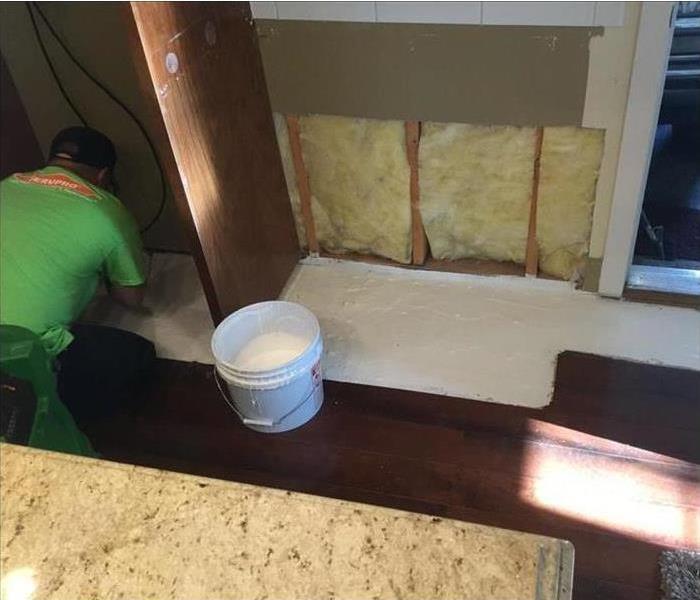 Cleaning up after water damage in a Billings, MT home
Cleaning up after water damage in a Billings, MT home
4 Easy Tips for Repairing Water Damage in Your Home
Water damage, whether it be from a flood or broken pipes, can be a hassle to deal with. It’s easy to be discouraged when faced with the tremendous task of recovering from damage to your home. Don’t despair! With these quick tips, you can begin restoring your home back to its original condition.
Remove Moisture from the Damaged Area
It should be a priority to dry out the affected area as soon as possible before more damage occurs. You can start water cleanup with pumps, a wet/dry vacuum, or a sponge. Ensure air is circulating by opening all windows and doors, using fans to speed up drying, or installing dehumidifiers.
Take Stock of Your Items
You will need to look through your home and discard damaged materials. Porous items are easily damaged by exposure to moisture and can also be breeding grounds for mold and mildew to spread. Carpet that has been soaking in water will most likely have to be removed and disposed of. The same applies to insulation, fabric and similar items.
Clean and Disinfect
Once the materials affected by water damage have been discarded, it’s time to clean the entire area. You can do this with a light bleach solution or an eco-friendly homemade vinegar spray. Lightly coat all surfaces in the solution of your choice and wipe down to ensure the areas have been thoroughly disinfected.
Inspect for Mold and Mildew
During your cleaning process, it’s wise to keep an eye out for mold and mildew that may be forming. It only takes 24 hours for mold to grow so it’s best to move quickly. Mold and mildew can be very damaging to your home and for more serious cases it might be best to consult a professional service that specializes in moisture damage restoration.
Water damage can be challenging to deal with, but the right tools and support it’s easy to turn the situation around. As a homeowner in Billings, MT, you can rest easy knowing that help is out there when you need it.
3 Main Steps to Sewer Damage Remediation
6/13/2019 (Permalink)
 Call a professional restoration company to cleanup a sewer damage
Call a professional restoration company to cleanup a sewer damage
Sewer backups portend more than just a smelly problem. Sewer water can contain illness-causing bacteria, so a backup is a bona fide emergency. Proper cleanup is critical to ensuring your Comanche, MT, home is safe. Learn what steps a sewer cleanup contractor should be following to be sure you’re getting your money’s worth.
Why Sewer Backup Is Dangerous
Sewer backups and resulting damage are considered unsafe because of the many microbes typically present in the water.
The Three Main Types of Contaminated Water are:
Category 1 water, which comes from a broken water supply line or a leaky faucet
Category 2 “gray water” is soiled by things like a flooded toilet or dishwasher overflow
Category 3 “black water” comes from floods or heavily soiled toilets and is the most dangerous type of contaminated water
What’s required to clean any of these water types can vary, but there are a few core things you should expect from sewer cleanup.
Thorough Drying
Drying is one of the top goals of any water damage remediation. A good contractor should bring industrial dryers and dehumidifiers to minimize air moisture and encourage more circulation. They should also have a plan for drying out items at just the right speed.
Disinfection
This is perhaps the most serious part of sewer water cleanup. Cleaning should involve pumping in disinfectants as well as thoroughly wiping down items with antibacterial solutions.
Deodorizing
Water damage - especially from sewage - can leave odors. A good contractor will have in place a plan to address stale, stagnant odors. That should involve ozone deodorizers and other equipment meant to truly remove odors, not just mask them.
Sewer cleanup is nothing to play around with. Besides funky smells, sewer water can harbor bacteria that is often dangerous. Use the above pointers to help you find the ideal water remediation company to get your sewer damage cleanup done right the first time.
How To Avoid Water Damage at a Construction Site
4/17/2019 (Permalink)
 A plumber can provide water pipe repair, for mitigation and restoration service SERVPRO should be your first call!
A plumber can provide water pipe repair, for mitigation and restoration service SERVPRO should be your first call!
Water damage during construction can result in delays, increased costs or even structural problems. Contractors should plan ahead to allow for drainage and quickly provide water pipe repair. Here are several ways to limit damage on a construction site in Billings, MT.
Control Quality
A quality control program is essential for any construction project. This program enables contractors to prevent or quickly respond to many risks, including a broken pipe or other conditions that could result in a flooded site. Quality control should account for the following factors:
• Primary plans and specifications
• Subcontractor work
• Checking punch-lists
Quality assurance is essential throughout the construction process and for warranty issues during and after project close. Program members should work closely and even overlap with a team dedicated to managing water damage risks.
Form a Dedicated Water Protection Team
A dedicated team of employees, consultants or subcontractors should be tasked with monitoring water-related issues from planning to completion. This team should approach water protection in several ways:
• Tracking risks and problems
• Monitoring progress
• Resolving issues
A water protection team should generate and resolve water-related punch lists. This team is critical early in a build, when members will monitor drainage and dewatering setup, the installation and testing of piping systems and any need for water pipe repair.
Front-Load Piping Installation and Testing
It is advisable to install and test piping early in the construction process to limit damage to finished materials. Other tests must take place after the roof has been installed, such as water tightness and sprinkler system pressurization and charging.
These measures can reduce the likelihood of water damage at a construction site in Billings, MT. If a broken pipe or any other cause of water damage affects a new building after project close, a plumber can provide water pipe repair and mitigation and restoration experts can handle damage to finished materials.
4 Mitigation Measures for a Leaking Water Heater
3/23/2019 (Permalink)
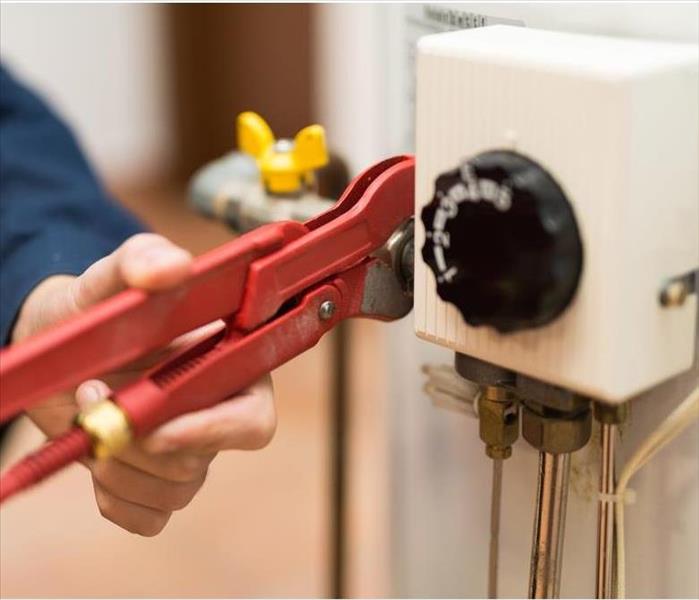 Water heater being looked at in Billings, MT, by a SERVPRO technician.
Water heater being looked at in Billings, MT, by a SERVPRO technician.
A leaking water heater can cause significant water damage at a residence in Billings, MT. Homeowners should take these four measures to mitigate damage.
Leaking Water Heater Tips
- Reduce the Risk of Shock
Start by unplugging electrical devices near the heater and switching off power to nearby circuits. Turn off the flow of water and electricity or gas to the heater before inspecting this appliance for leaks. - Try To Identify the Cause
It may be easier to mitigate damage if you can determine where a leak originates. Check the supply line, gaskets and valves. If a leaking water heater is caused by a corroded tank, you will need to replace the appliance. Depending on the location of the leak, you may want to drain the water tank. - Drain the Tank
Make sure the supplies of gas or electricity and water are shut off. Run hot water in a sink or tub to drain the tank, and open the pressure relief valve to permit water to drain more quickly. Allow any water remaining in the tank to cool before connecting a hose to the drainage spigot to empty the tank. This procedure can limit the amount of water that leaks out of a broken water heater. - Dry the Area
Use a mop or wet vac to extract standing water from floors and remove wet materials such as carpet. Ventilate the area with fans to promote drying, and consider using a dehumidifier or desiccant such as silica gel on soaked walls or floors.
These measures can be helpful for mitigating damage caused by a leaking water heater. You may be able to address minor issues on your own. A plumber or appliance repair specialist can help with a failed water heater. If a leak results in extensive water damage, rely on the expertise of a mitigation and restoration company in Billings, MT.
3 Tips for Protecting Your Home’s Water Pipes During Cold Weather
1/23/2019 (Permalink)
 Frozen pipe in a Laurel, MT home
Frozen pipe in a Laurel, MT home
3 Tips for Protecting Your Home’s Water Pipes During Cold Weather
When frigid temperatures arrive, they can affect your Laurel,MT, home in many ways. However, one way they can be extremely damaging is when they cause frozen pipes both inside and outside. When water pipes become frozen, they can burst without warning and cause serious flooding that can ruin walls and flooring. Fortunately, there are several ways you can prevent this issue and safeguard your property when cold weather strikes.
1. Search for Air Leaks
When cold air is allowed to seep into your home, it can contribute to pipe freeze and flooding when pipes become cold enough to burst. You can reduce the risk by searching for air leaks inside your home and sealing them with fiber insulation or caulk. Air leaks can be commonly found around vents, loose electrical plating and near joists in unfinished areas, such as utility or mud rooms. If you find air leaks, take the opportunity to check any nearby pipes for signs of wear or damage.
2. Expose Hidden Pipes to Warm Air
Pipes hidden under cabinets, such as those in your kitchen and bathroom, can be more prone to freezing because they are rarely exposed to warm air. Opening your cabinets during freezing temperatures can prevent this and a pipe burst that could result in a serious flood. If you plan to leave your home overnight or for an extended winter holiday, leave the cabinet doors open and allow the warm water faucet to drip slightly, which can prevent these pipes from freezing over.
3. Winterize Your Pipes Before Cold Weather Hits
Taking time to winterize your home during the fall can lower the risk of frozen pipes later on. Have a flood damage and water removal company come in to inspect your water lines and ask technicians advice about steps you can take to protect your pipes now.
Frozen pipes can cause serious water damage to your Laurel,MT, home. Knowing how to prevent this problem could go a long way in helping you save the time and money it takes to make repairs in the aftermath.
Tips for Avoiding Flooding During Cold Weather
10/19/2018 (Permalink)
 Protect your business in Laurel,MT against frozen pipes
Protect your business in Laurel,MT against frozen pipes
Flooding isn't the only type of storm damage that could affect your business properties; freezing weather could lead to a burst pipe. One property of water is that it expands when it freezes, and during this process, metal and plastic pipes are put under a lot of pressure. As cold weather approaches, watch out for the following at-risk pipes:
- Exterior pipes, such as water sprinkler lines and outdoor hose bibs
- Pipes in unheated areas of the building, such as basements and garages
- Interior pipes that run along exterior walls with little to no insulation
There are several things you can do to protect against a frozen pipe and decrease the risk of flooding because of a burst pipe.
Prepare for Cold Weather
Drain all water from hoses before putting them away and close valves between the interior and the exterior of the building. Clear sprinkler supply lines and drain standing water from landscaping features. Add insulation around interior pipes in unheated areas and against exterior walls. It doesn't take much insulation to protect against freezing. Some products, such as pipe sleeves and heat tape can boost the level of protection.
Adjust Your Habits When Temperatures Drop
Leave the thermostat set at the same temperature during the day and the night, even if employees and staff have left for the day. The increase in your heating bill is sure to be much less than the cost of hiring emergency remediation specialists and any losses you may incur if you aren't able to maintain business operations. You may also want to leave a slow drip through the faucets and open cabinet doors to allow warm air to flow around pipes.
Cold weather in Laurel,MT, could lead to water damages that don't have anything to do with flooding or heavy rainfall. Avoid expensive repairs and the loss of profits by planning ahead and preventing storm damages related to cold temperatures.
First Steps: What To Do When A Pipe Breaks
10/10/2018 (Permalink)
 Water damaged kitchen due to a burst pipe in Billings,MT
Water damaged kitchen due to a burst pipe in Billings,MT
Many things can cause water damage to your home in Billings, MT, even elements of the home itself. Bursting pipes are not something you necessarily expect, but it's good to have a plan in place just in case. The faster you can spring into action, the less water damage the broken pipe is likely to cause. Here are some suggested first steps to take if a pipe breaks in your home.
1. Shut Off Supply
The first thing you should do is halt the problem. To do this, you need to stop the flow of water into the pipe. Turn off the water at the main valve, thus limiting the volume that will need to be extracted. It is also advisable to shut off the power, at least to the immediate area where the flood is located. This minimizes the danger of water taking on an electrical charge and causing possible injury to anyone who comes into contact with it.
2. Call Mitigation Services
The sooner you call water restoration specialists about bursting pipes, the better off you'll be. If technicians can get to your home quickly, they can often fix the broken pipe and prevent a lot of the secondary damage that could happen if water is allowed to sit stagnant in your home. You may have to replace fewer inches of drywall. You may even be able to avoid a mold problem.
3. Start Extraction
If you have the appropriate protective gear, such as rubber boots and gloves, you may want to start extracting some of the water before the professional technicians arrive. There's no such thing as removing excess water from your home too soon. As long as you can remove it safely, there's no reason to let water linger longer than necessary.
Most of the work of fixing the damage caused by bursting pipes will be handled by the professionals. Your responsibilities are to get them there quickly and make sure the job is as easy as possible once they arrive.
The Secret Life of Water Supply Lines
6/20/2018 (Permalink)
 Your home’s high-pressure water can cause serious supply line damage in a short amount of time once the integrity of the tubing is breached.
Your home’s high-pressure water can cause serious supply line damage in a short amount of time once the integrity of the tubing is breached.
The water supply line is generally hidden near the floor behind the toilet and routes water from your home’s main lines to the commode. Sine the plastic or steel lines seldom leak, the tubes can often be ignored for decades. It is only when a puddle appears on the floor behind the toilet bowl that the lines come under scrutiny. The problem can be a serious one because almost any type of bathroom leak can cause a great deal of damage in a short amount of time. Since the line can often go unnoticed, the supply line damage may often be overlooked as well.
Where Are the Lines Found?
Water supply lines are not just found in bathrooms. The tubes can also play an important part in connecting several appliances to the main water line in the house. These appliances include:
• Washing Machines
• Bathroom sinks
• Kitchen sinks
• Dishwashers
The lines are also used to connect toilets and bidets to the home’s high-pressure water valves.
What Type of Lines Are Available?
The supply line is intended to mitigate the water pressure from the main line to the appliance. To prevent supply line damage, the tubing is specially designed to withstand a great amount of pressure over a long period of time. Stainless steel braided hoses, copper pipes, and durable plastic lines are the most popular type of supply line tubing used in modern home construction in Billings, MT, and all three have proven themselves reliable in preventing a supply line leak.
What Happens When a Line Leak is Found?
Your home’s high-pressure water can cause serious supply line damage in a short amount of time once the integrity of the tubing is breached. For that reason, calling in a professional water mitigation team as soon as you find the leaking line can often prevent a flood. The sooner the water flow can be stopped, the less potential damage there may be to worry about tomorrow. For more information, visit http://www.SERVPRObillings.com/.
3 Ways To Make Sure Your Restaurant Stays Free of Mold Growth After Water Damage
4/26/2018 (Permalink)

Having to deal with mold growth in a restaurant is something that no owner wants to endure. An establishment that contains both food and moisture can be the perfect place for it to thrive. Owning a restaurant in Billings, MT, with its high humidity, means that extra care should be taken. Likewise, if you have a busy kitchen with areas that are susceptible to water damage, you should take the following steps to minimize the likelihood of mold.
1. Good Ventilation
The very nature of a restaurant, with lots of steam and water around most of the time, means that if the area isn’t well ventilated, then mold could appear. Installing ventilation equipment in the main cooking and dish-washing locations and arranging for it to be consistently maintained could help to prevent the conditions that cause invasive growth.
2. Staff Training
Ensuring that all staff members are trained in how to handle food safely and hygienically means that the risk of mold appearing on it may be greatly reduced. Employees should also be aware of the importance of keeping all of the restaurant equipment clean and the temperature in the restaurant stable to avoid high humidity. This training can help to reduce the risk of mold growth on food.
3. Checking Hidden Areas
Checking areas in the restaurant that may not be easily visible is typically extremely important. These locations can sometimes be the most predisposed to mold. Areas hidden behind sinks or kitchen equipment can have water damage that has not been discovered, providing the perfect environment for the mold to grow. Moving equipment regularly, checking for moisture and cleaning behind, underneath and on top of it can be an ideal way to avoid this.
Mold growth in your restaurant can be stressful. However, following the above steps can help you decrease the chances of it happening in your location. For more information, visit http://www.SERVPRObillings.com/.
Managing Leaks Under Your Kitchen Sink: 3 Steps for Minimizing Damage
3/22/2018 (Permalink)
Kitchen leaks are a common household issue. However, when one happens in your Billings, MT home, it may feel like a major disaster. Flooding, broken pipes and a soaked floor can be costly and time consuming to repair. However, there are a few actions you can take to minimize the damage caused by leaks under your kitchen sink.
1. Shut Off the Water
Turning off the water in your home can stem the flood waters, especially if a broken pipe is causing it to gush out rapidly. Know where the shutoff valves are so you do not have to waste time looking for them during a plumbing flood. Turning off the water might also help you see what type of damage you are dealing with.
2. Call Your Insurance Company
Calling your insurance company right away after a flood is a wise idea because it can help you file the same day, which may result in a quicker payout for kitchen repair. Go over the details of the flooding with your agent, and let him or her know whether you need to take pictures or if the company plans to send a claims adjuster. Reaching out to your agent quickly may also prevent delays later, when the claim is reviewed.
3. Call for Flood Cleanup
Flood cleanup and restoration services can offer you helpful assistance after a kitchen flood. Not only can flood techs remove the water and prevent it from spreading to other rooms, they can advise you about what types of repairs you might need afterward. They can also assist with mold prevention and the removal of damaged cabinetry.
When a leak under the sink happens in your Billings, MT home, it can be a stressful experience. Knowing which immediate steps to take can help you minimize flooding and put you on the path to assessing and repairing the damage. Visit http://www.SERVPRObillings.com for more information on water damage.
How a Bad Water Heater Threatens Your Home
1/8/2018 (Permalink)
Tucked away in a closet or perhaps living out in the garage, the water heater is one appliance many take for granted. That first cold shower after a failure is often what reminds people what a luxury hot running water truly is, but discomfort during bathing is just a minor risk. It’s important to notice any evidence of a leaking water heater, as this can quickly become a broken water heater, a problem capable of causing major damage to your home.
Warning Signs To Watch For
There are numerous red flags that may arise to warn you about a leaking water heater, both inside the home and near the unit itself. These include but are not necessarily limited to:
• Banging or rattling noises when running hot water caused by sediment deposits in the tank
• Rusted or corroded connections extending from the heater
• Clouded or bad-smelling heated water
• Visible signs of water near the tank
Often, homes in Billings, MT continue to rely on heaters that are over 10 years old. This is the approximate time frame wherein these appliances frequently begin to fail, so pay extra attention if your home is running an older unit.
What To Do When Problems Occur
The first step is to confirm that a leaking water heater is actually the root of your trouble. Ensure that pipe problems aren’t the origin, and rule out any other possibilities before proceeding. If the heater’s the culprit, terminate its power source (electric or gas) if you can do so safely. The water supply should come next, at which time you can begin necessary repairs or replacement. If a failed water heater has already created any type of flooding, make sure to counteract the effects as soon as possible. Restoration professionals can help remove floodwater and advise you on how to prevent any further damage that may result from excess moisture or humidity in the home. Visit http://www.SERVPRObillings.com for more information on water damage.




 24/7 Emergency Service
24/7 Emergency Service









































